Armor
Medieval armour not only offered protection on the battlefield, but also represented the status and skill of warriors.
In this armour FAQ, you'll find clear answers to common questions about materials, maintenance, and the differences between armour styles that existed throughout the centuries.
Find out how to choose the right armour for you, how to care for it properly, and much more. Everything you need to know about historical armour is here in this comprehensive guide.
The kabuto is an essential component of Japanese armor, holding a prominent place in the military history of feudal Japan. This elegant helmet not only protects the head and face of the warrior in combat situations but also represents a symbol of status and skill. Even today, the kabuto is used in traditional ceremonies and festivals, bestowing an air of reverence towards Japan's rich cultural heritage.
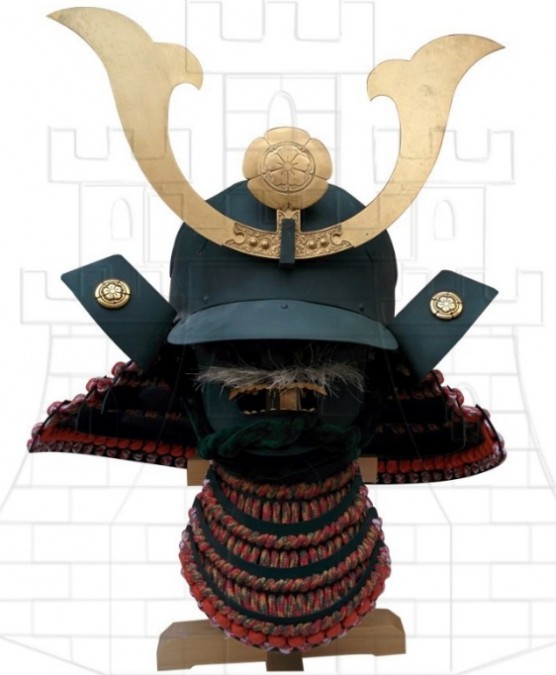
Kabutos are recognized for their captivating aesthetics, with intricate details that often reflect elements of nature, wildlife, and divine figures. As metallurgy technology advanced, designs became more complex, incorporating new ornamental elements and better materials. Initially, kabutos were simpler and more functional; however, over time they evolved into rich expressions of art and craftsmanship.
A distinctive aspect of the kabuto is the maedate, an ornament placed on the top of the helmet. Generally, this emblem was a metal crest or a sculpture representing the warrior or their clan, thereby allowing identification of their status and loyalties. Along with the maedate, another crucial element is the shikoro, a neck guard that hangs from the lower edge of the helmet, made up of multiple plates of metal or leather that provide additional security to the wearer.
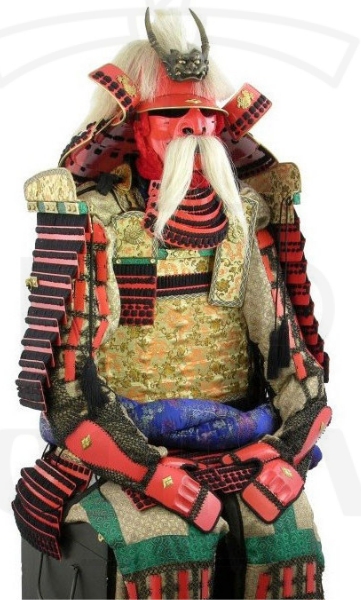
Kabutos were considered family treasures, often passed down from generation to generation, and their care and maintenance were carried out with great diligence. Owning a kabuto was not only a symbol of wealth but also of a deep respect for the art of war. Today, they are admired in cultural festivals and parades, as well as being central pieces in art collections that preserve Japanese history.
In summary, the kabuto is not just a piece of armor; it is a testament to Japan's historical and artistic legacy, valued for both its functionality and aesthetic beauty.
The sode is a fundamental piece of the samurai armor, playing an essential role in the protection of the warrior. It is a rigid plate that protects the shoulders, fastening to the dō (central part of the armor) with straps and buckles, thus ensuring a secure and effective fit. The shape and size of the sode have evolved over the centuries, marking significant milestones in the history of Japanese armor.
During the Heian period (794-1185), the sode were relatively simple, exhibiting a rectangular design that covered only the shoulders. However, it was during the Muromachi period (1336-1573) that these pieces transformed into more elaborate elements, adopting curved shapes that not only protected the shoulders but also extended their coverage to the arms, offering greater defense in combat.
The materials used in the making of the sode vary considerably, adapting to factors such as budget, climate, and desired functionality. The sode could be made of:
- Leather: Flexible and lightweight, ideal for warm climates or for activities requiring agility, such as horseback riding.
- Silk: Often used for decoration, adding a touch of distinction.
- Metal: Provided greater protection, albeit at the cost of increased weight and reduced flexibility.
- Bamboo: A lighter and more versatile option that was also used in certain sode.
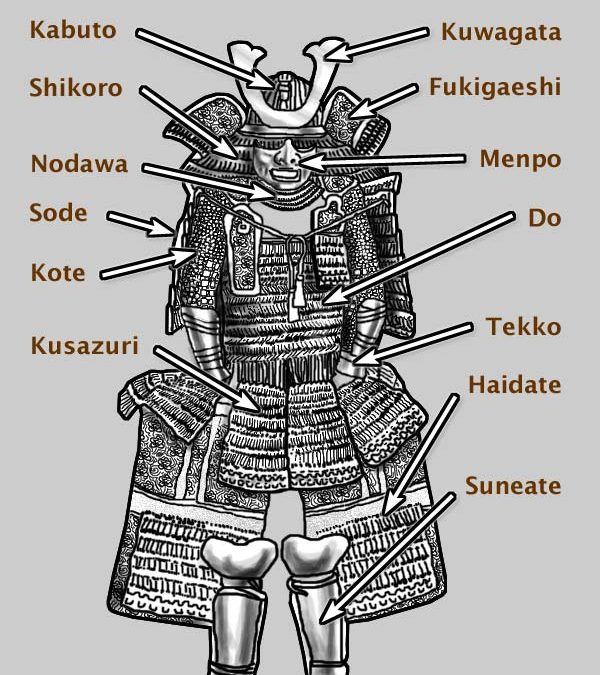
Beyond their defensive function, the sode were also a symbol of status and wealth. Samurai used these pieces to showcase their social distinction; some were decorated with intricate relief designs, such as flowers and animals, while others featured elaborate paintings or prints. Additionally, many sode incorporated the mon (family crest) of the samurai, facilitating the identification of the warrior in the heat of battle. In this way, the sode not only provided protection in battle but also served as a visual and symbolic record of the samurai's identity.
The Nodawa is a fundamental piece of traditional Japanese armor, specifically designed to protect the warrior's neck and throat during confrontations. This crucial component of the armor, which takes the shape of a metal plate, gently curves around the neck and secures to the shoulders, providing vital protection in one of the most exposed areas of the body in combat.
Beyond its physical protective function, the Nodawa also acts as a type of high collar, shielding the warrior from cold winds and rain, making it a practical element in the context of Japanese weather. Its design was not only focused on defense; over the centuries, the Nodawa also evolved aesthetically, incorporating a variety of styles and decorations. These embellishments often include intricate motifs of dragons, flowers, and other symbols that resonate with Japanese culture and mythology, adding a level of sophistication that elevated its value not just as protection, but also as a manifestation of art.

The Nodawa not only served as a protective element; it was also a symbol of status and rank within the Japanese army. Variations in its design and ornamentation could indicate the level of leadership or social position of the warrior wearing it. Thus, not only was the physical integrity of the combatant cared for, but their dignity and honor on the battlefield were also reflected.
Today, the Nodawa has become a piece of cultural and historical interest and can be seen in traditional Japanese armors used in ceremonies and historical festivals celebrating this rich heritage. Additionally, it is common to find it in museums that house collections of historical artifacts, as well as in private collections of Japanese armor enthusiasts.
This cultural legacy reminds us not only of the importance of the Nodawa as protection but also as a legacy of the rich martial tradition and aesthetics of Japanese history.
Quijotes or musleras are fundamental elements in the history of medieval armor, specifically designed to protect the upper legs, particularly the thighs, of warriors and knights on the battlefield. These armor components are the result of significant evolution over the centuries, reflecting the various protection needs that arose in different cultural and geographical contexts. During the Middle Ages, a period characterized by frequent armed conflicts, the demand for robust defenses was essential for surviving the assaults of weapons such as swords, spears, and arrows.
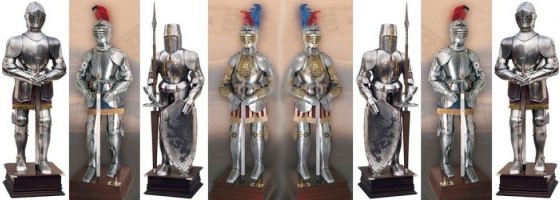
In their construction, quijotes or musleras are generally composed of several articulated metal plates, which can be made of steel or iron, connected by leather straps, rivets, or hinges. This articulation is essential, as it allows the warrior to maintain a degree of mobility and flexibility despite the weight of the protection. In addition to fulfilling their guarding function, quijotes integrate with other pieces of armor, such as the waist and greaves (which protect the shins), as well as the poleyns (intended to guard the knees). This comprehensive defense system provides complete coverage for the lower limbs, crucial for any combatant.
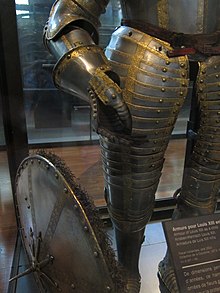
Quijotes also adapted to the diverse martial traditions of the cultures where they were employed. For example, some designs incorporated an additional protection known as
The armor ristre is a term that refers to the collection of weapons, tools, and accessories that a warrior or knight carried at their waist or hip during the medieval period. This repertoire included a variety of objects, such as swords, knives, axes, and war hammers, which were essential both in combat and personal defense. In addition to weapons, the ristre could incorporate indispensable tools such as sharpening stones, wallets, and provision bags, becoming an invaluable tool for those facing the dangers of the battlefield.
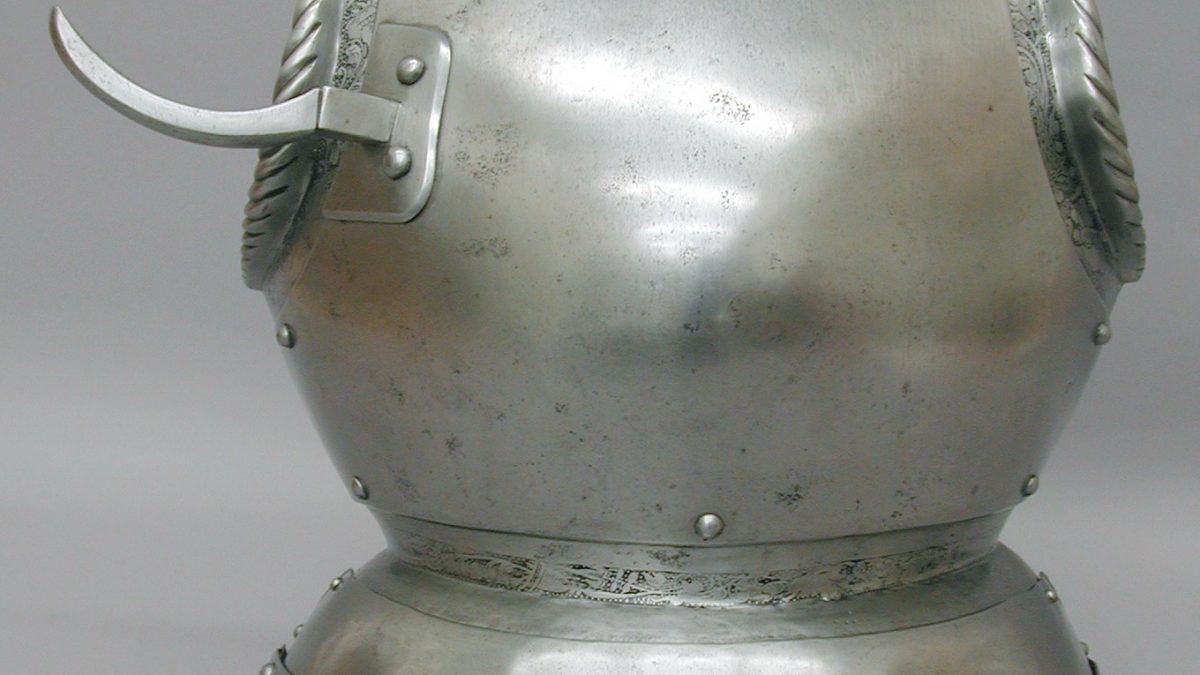
The importance of the armor ristre lies not only in its practical function during confrontations but also in the symbolism it represented. This collection of weapons and tools was secured to the warrior's waist with a leather or fabric belt, which often featured ornamental decorations that revealed the status and wealth of the bearer. Therefore, the ristre not only served as a means of defense but also as a showcase of the social and economic identity of the warrior.
Within this collection, the pouch was a particularly useful element. It allowed for the transport of essential provisions such as food and water, as well as the safeguarding of small objects like coins and tools. The design and ornamentation of these pouches varied depending on the social status of the warrior, reflecting their wealth and personal tastes.
In the broader context of medieval trade, armor ristras were also objects of exchange, and their quality could determine a knight's prestige in court or in battle. With the rise of weapons trade during the Middle Ages, these accessories began to be crafted with more detail and style, becoming truly unique and personalized pieces that laid the groundwork for the current market of medieval reproductions.
Thus, the armor ristre is much more than just a simple set of tools; it is a symbol of the medieval era that combines pragmatism and aesthetics, uniting personal defense with the expression of social status. These elements have notably influenced the cultural representation of medieval warriors today and continue to be of interest to collectors and enthusiasts of the medieval world.
The breastplate is one of the essential pieces of plate armor, a type of protection predominantly used during the medieval period. This form of armor is characterized by being made with metal plates that are assembled in a way that ensures extensive coverage of the wearer's body.
In particular, the breastplate efficiently covers the lower part of the torso and the abdomen, areas that are crucial and vulnerable in combat. This piece not only provides physical protection against cuts and blows but is also an essential element in the design of the armor. The breastplate is attached to the cuirass by means of straps or buckles, and works in conjunction with other parts of the armor, such as shoulder plates, greaves, and tassets, to offer comprehensive defense. On various occasions, the breastplate could be separated from the armor set, allowing the user to use it independently for more specific defense in the waist and abdomen area.

The popularity of the breastplate in Europe consolidated during the 14th century and continued to evolve through the 15th and 16th centuries. Over time, it transformed into a more complex and ornamental piece. Many of these breastplates were adorned with detailed engravings or inlays that not only increased their visual appeal but also enhanced their value as an art object. Aside from its defensive function, the breastplate had an aesthetic and symbolic meaning. It represented status and power, reflecting the skill and mastery of the armor maker who had crafted it. In some cases, these artisans incorporated coats of arms or family insignias into the breastplate, creating a unique and personalized piece, making it a significant element for its bearer.
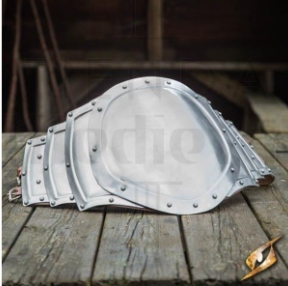
The breastplate is not only a testament to the technological advancement in armor manufacturing but also reinforces the individuality and social achievements of the warriors and knights who wore it. This essential piece of plate armor reflects a balance between functionality and aesthetics, ensuring that its legacy endures throughout European military history and combat culture.
The barbera, also known as barbote, is a fundamental piece of medieval armor that played an essential role in protecting the warrior. This device was attached to the helmet to safeguard the lower part of the face, including the mouth, chin, and jaws. Throughout history, the barbera has received multiple names, such as babera, baberol, barberol, babador, barbique, baberón, barbete, and guardapapo.
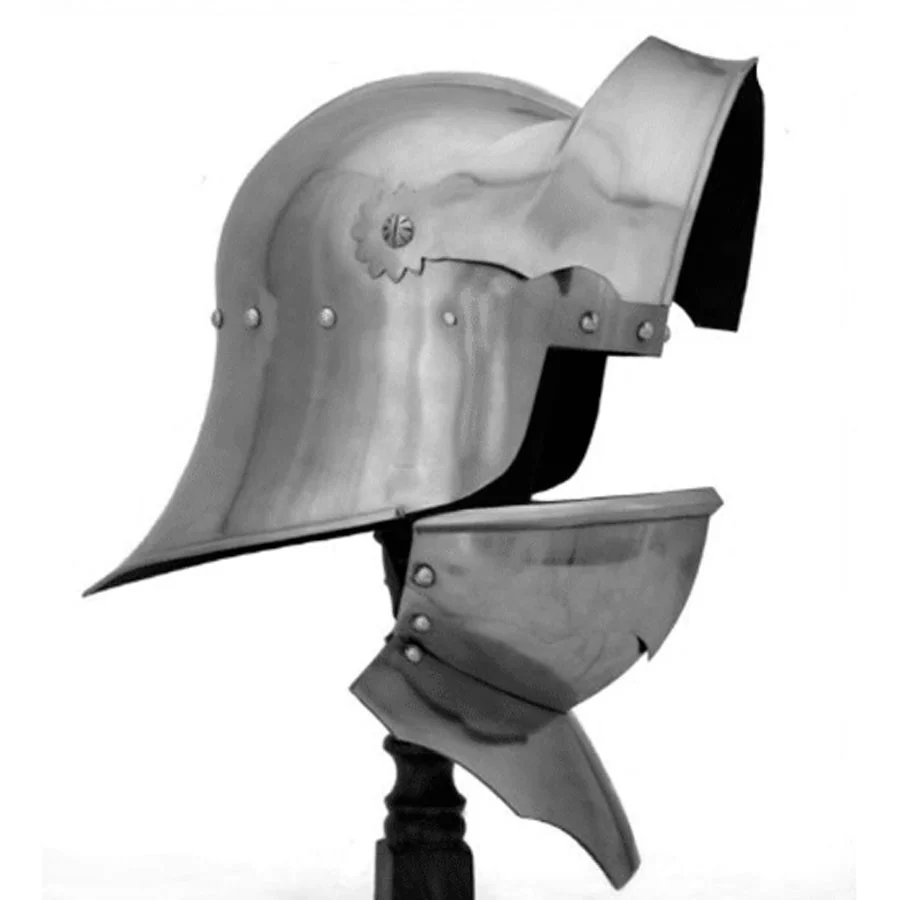
Its use dates back to the mid-14th century, and its initial design was conceived to provide support for the bacinete, a type of helmet that, due to its weight and structure, could move unstably during combat. Over time, innovations such as the gorguera or gorguerín, which was attached to the coselete and espaldar with straps, significantly improved its functionality and protection.
The main function of the barbote is to secure the protection of the following areas of the warrior on the battlefield:
- Mouth
- Chin
- Jaws
Barbotes were commonly made of steel and iron, ensuring their resistance during fights.
Barbotes adapted in various ways to different types of helmets and headpieces of the time, demonstrating impressive versatility:
- Bacinete: The barbote was attached with straps or hinges, allowing the warrior to lift and lower it as needed, thus providing additional protection without sacrificing mobility.
- Closed helmet: In this type, the barbote was an integral part of the helmet, extending from the bottom to protect the warrior's face and neck.
- Great helmet: Designed to be more robust, the barbote in these helmets extended up to the upper chest, especially in the Spanish models of the 15th and 16th centuries, known as
The gorjal, also known as gorget, is a key piece of medieval armor designed to offer protection to the neck and upper chest of the warrior. Its importance in combat is undeniable, as it plays a critical role in defense during battles. Below are the most relevant aspects of this fundamental piece of war attire from the era:
Main Functions
- Neck Protection: Acts as the first line of defense for this vulnerable area, preventing cuts and thrusts.
- Structural Support: Provides a solid foundation for other pieces of armor, such as the helmet, increasing the warrior's stability and protection.
- Integration with Armor: Attaches to the breastplate and backplate, creating a protective wrap that ensures complete upper torso defense.
Main Characteristics
- Location: Positioned at the top of the chest, covering the back of the neck and shoulders.
- Structure: Generally consisted of a neck made of iron divided into two articulated pieces, designed for easy adjustment.
- Materials: Typically made of metal, such as iron or steel, which provided the necessary robustness to withstand impacts.
Evolution and Use
- It was one of the first pieces to be worn when dressing in armor.
- In some cases, a high gorjal could replace the collar, which specifically protected the front of the neck.
- Its design evolved to improve both mobility and protection, in response to changing combat tactics.
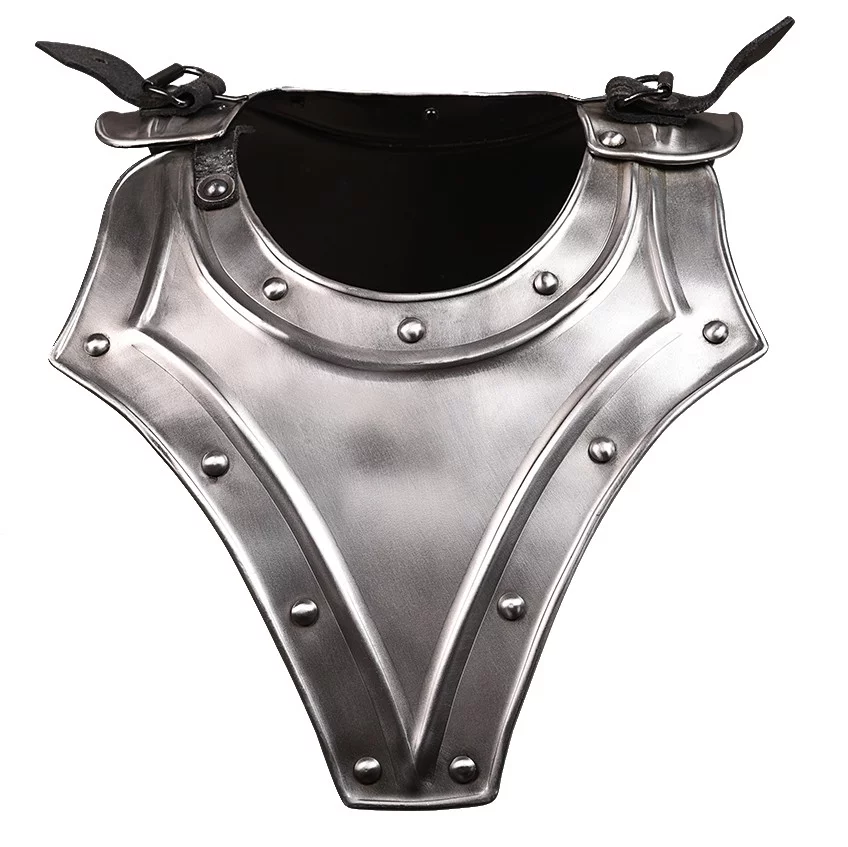
Fit and Comfort
The fit of the gorjal was essential for its effectiveness in combat. It was achieved through various methods:
- Articulated Design: Thanks to its construction in two pieces, the gorjal could be comfortably adjusted around the warrior's neck.
- Closure System: It usually closed with buckles and straps, allowing for personalized adjustment.
- Integration with Other Pieces: Joined to the breastplate and backplate, its design ensured it stayed in place during combat.
- Customized Fit: Armorers made gorjals to measure, ensuring an optimal fit for each warrior.
- Inner Padding: Often included leather or fabric padding for improved comfort.
- Ergonomic Shape: Its design follows the anatomy of the neck and shoulders for a more precise fit.
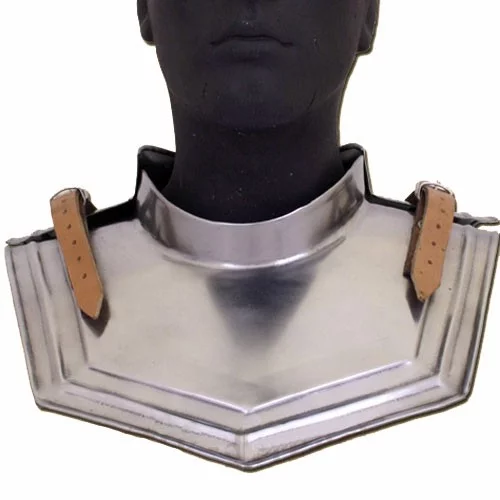
Critical Combat Situations
The gorjal became an indispensable piece in various battle situations:
- Protection Against Neck Attacks: Defends a vital area from cuts and thrusts.
- Defense Against Polearm Weapons: Helps deflect impacts in confrontations against spearmen.
- Close-Combat: Provides additional protection against opportunistic attacks.
- Cavalry Charges: Protects the rider during lateral and frontal impacts in initial clashes.
- Defense Against Projectiles: Although not its primary function, it can help reduce the impact of arrows.
- Support for the Helmet: Facilitates the weight distribution of the helmet, enhancing comfort in prolonged combats.
- Protection Against Rising Blows: Useful for safeguarding the neck and chin against upward attacks.
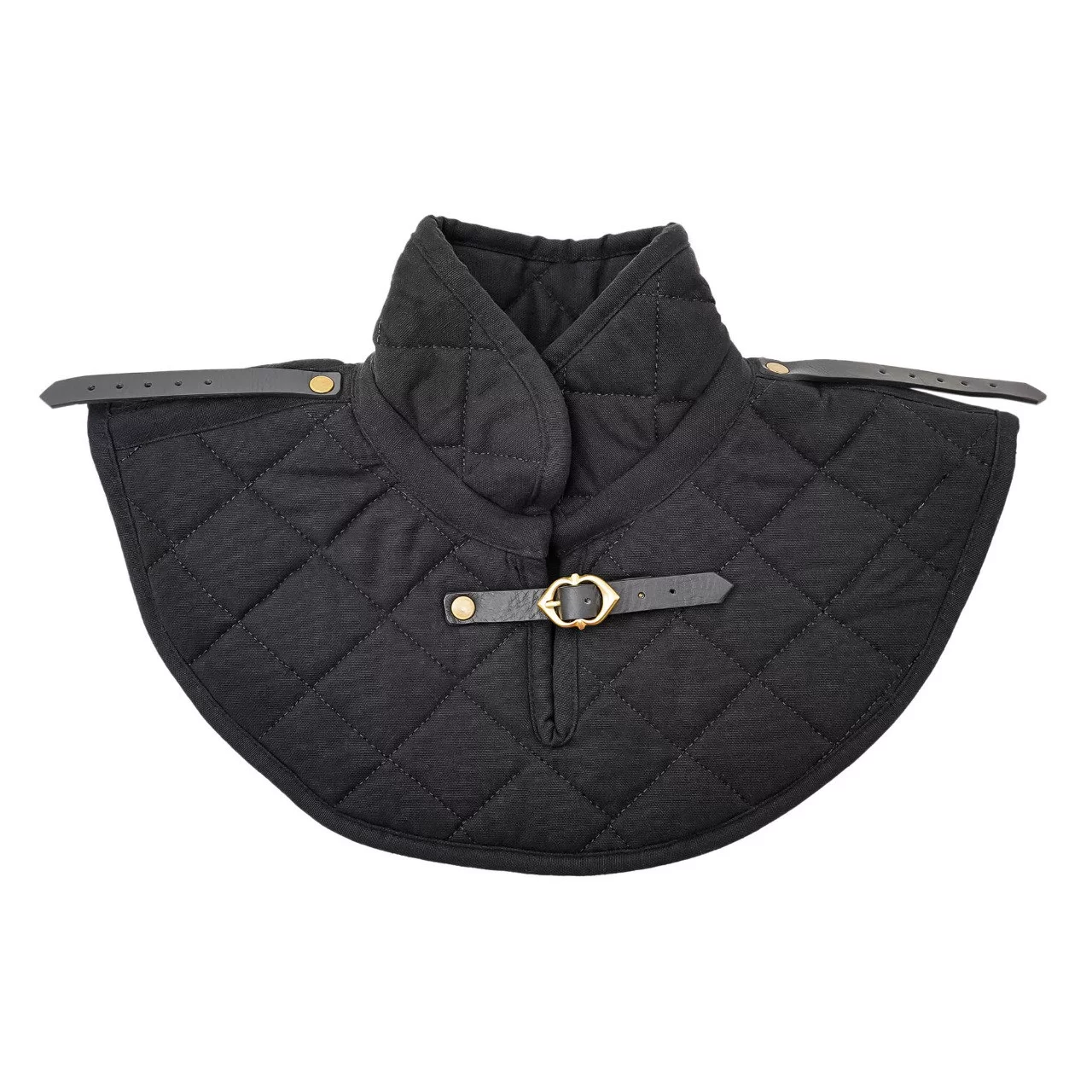
The gorjal, when integrated with other pieces of armor, formed a robust and effective defense system, crucial for the warrior's survival on the battlefield. Its design and functionality have left a significant mark in the history of personal protection in combat.
The alpartaz is a key piece in medieval armor, specifically a chainmail that protects the neck and shoulders of the warrior. Below are its main characteristics and importance in the historical context of armor.
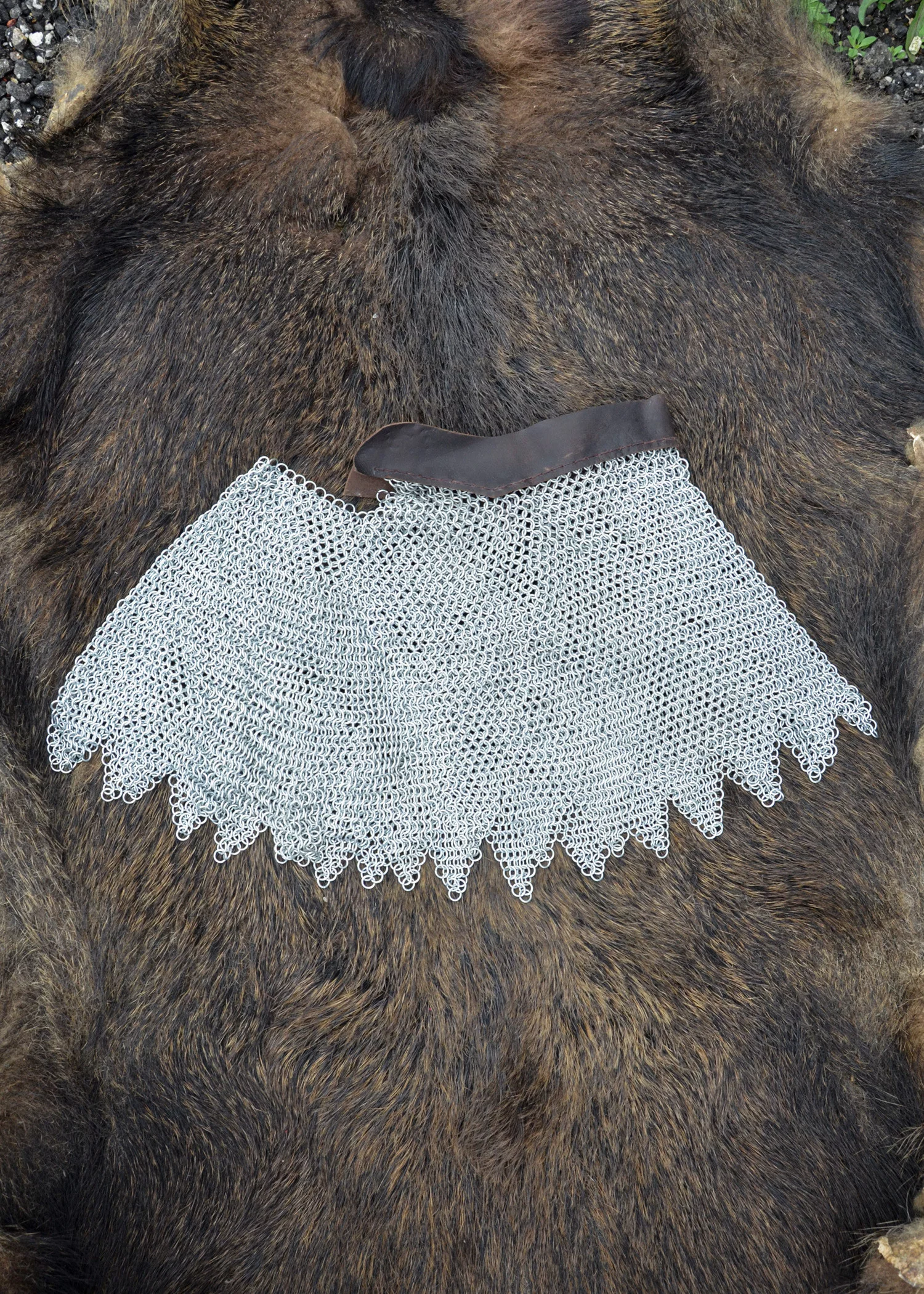
Definition and Function
The alpartaz is a flexible curtain of mail, designed to offer protection to the most vulnerable parts of the body during combat. Its main function is:
- To protect the warrior's neck and shoulders from direct attacks.
- To allow free movement of the neck, essential for mobility in combat.
- To complement the overall protection provided by other parts of the armor, such as the helmet and gorget.
Characteristics of the Alpartaz
Among the characteristics of the alpartaz, we can highlight:
- Material: It is generally made of metal mesh, providing both flexibility and strength.
- Location: It attaches to the edge of the helmet, ensuring a secure transition between the head and torso.
- Coverage: It extends from the helmet to the area of the neck and shoulders, ensuring continuous protection.
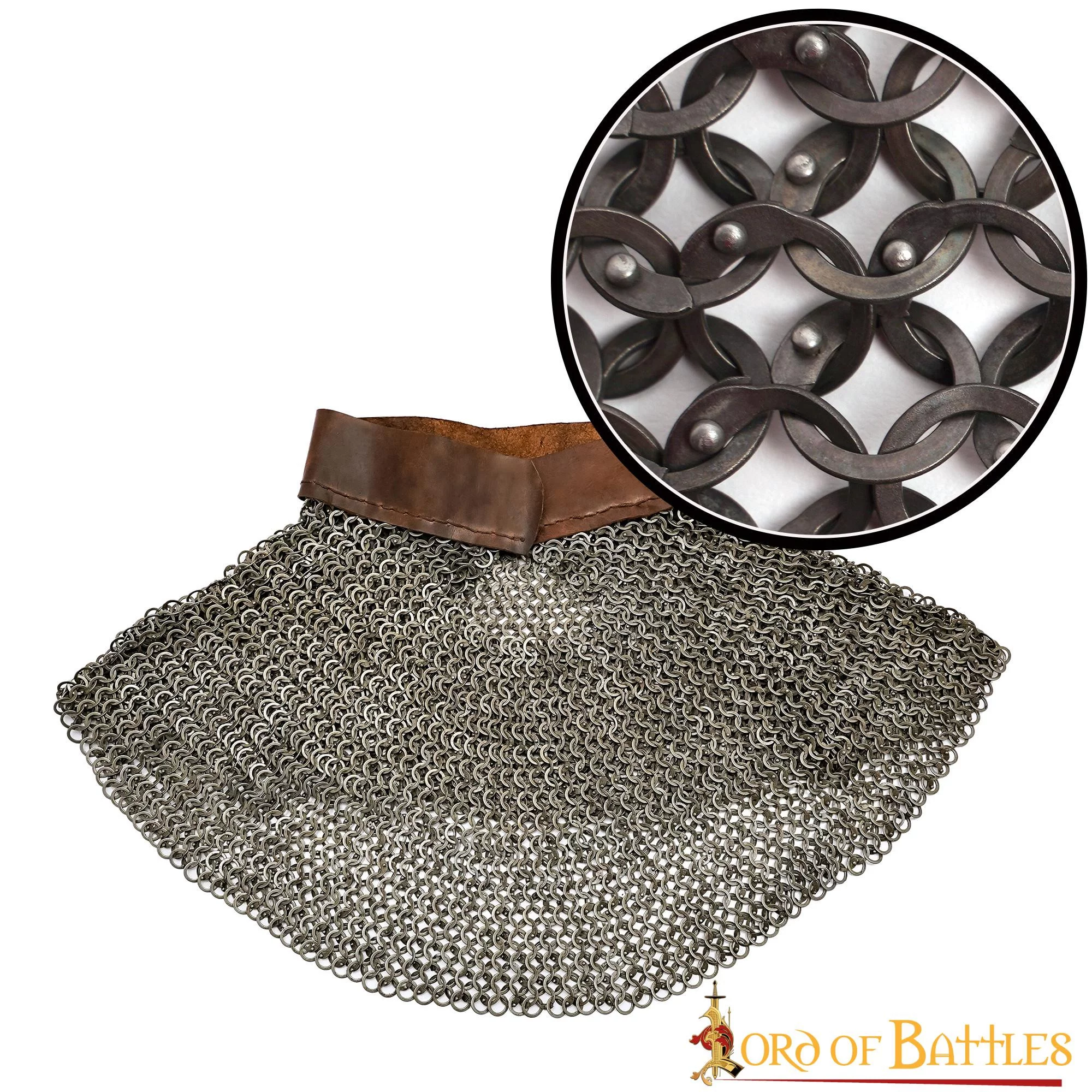
Historical Importance of the Alpartaz
The alpartaz played a fundamental role in the evolution of medieval armor. Its contributions are especially notable in:
- Protection of vulnerable areas: The neck and shoulders are exposed areas, and the alpartaz was specifically designed to reduce risks in these zones.
- Flexibility: Its structure allowed freedom of movement, something essential in battles where agility could be the difference between life and death.
- Composition of complete armors: By the end of the Middle Ages and the Renaissance, warriors wore complex armors that could consist of up to 250 articulated pieces and weighed between 25 and 30 kg.
Materials Used in the Manufacture of the Alpartaz
For the construction of an alpartaz, specific materials were used that guaranteed its functionality:
- Steel mesh: The main element, composed of interconnected steel rings with an approximate diameter of 8 mm. This interlacing pattern (4 rings to 1) offered good protection and flexibility.
- Leather: At the top of the alpartaz, a strap of cowhide is incorporated to facilitate attachment to the helmet.
- Fastening elements: Vervelles (small brass pieces) or leather cords were used to attach the alpartaz to the helmet, allowing easy disassembly for maintenance.
Fastening Methods
- Vervelles: These were fixed around the lower edge of the helmet, allowing a secure and accessible connection.
- Leather cords: They were threaded through holes in the edge of the helmet, intertwining with the mesh of the alpartaz.
- Wire: Similar to the use of cord, but using wire to secure the alpartaz to the helmet.
The alpartaz is a testament to the evolution of armor technology, which not only provided protection but also combined design and functionality exceptionally in the wartime context of the era.
Escarcelas, derived from the Italian term scarsella, are fascinating historical pieces that played an essential role in the armor of knights during the 14th and 15th centuries, particularly in Italy. These pieces were not only functional but often featured artistic designs and various styles that reflected the cultural richness of the time.
In the context of medieval armor, escarcelas were protective elements suspended from the belt, secured to the skirt of the breastplate with straps and buckles. Their fundamental purpose was to cover the weak point located between the skirt of the breastplate and the greaves, protecting the groin area and preventing the adversary's lances from inflicting damage on one of the knight's most vulnerable areas.
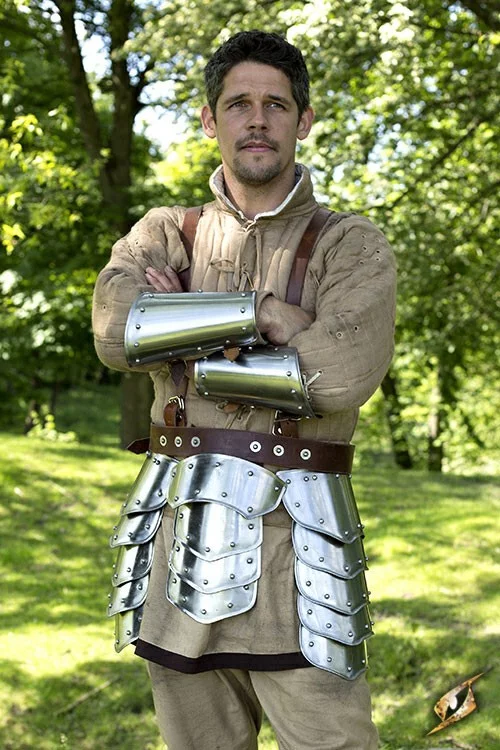
Characteristics and Evolution of Escarcelas
- Design:
- They generally consist of plates shaped like tiles, with an edge on the vertical axis.
- They were worn symmetrically, one on each side of the body, although in cavalry armor, the right escarcela could be shorter than the left to facilitate mounting.
- Evolution:
- Initially, they were nailed to the skirt of the breastplate, but later they were secured with straps to provide greater flexibility and mobility.
- During the 15th century, the transformation into Gothic armors allowed the use of curved and radiated edges, improving aesthetics and functionality.
- From the 16th century onwards, escarcelas were made in multiple articulated pieces, providing superior mobility for knights on the battlefield.
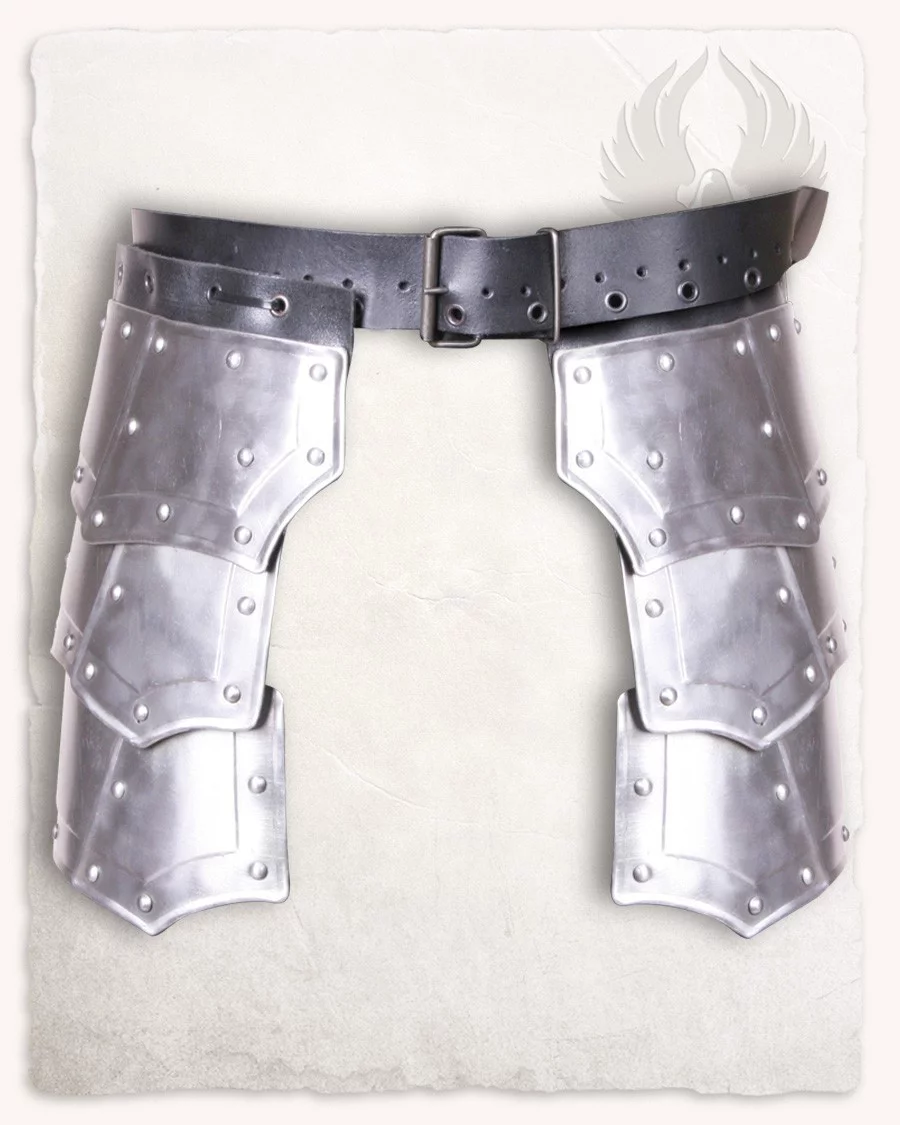
Variations in Design
- Foot combat armors: Often included additional escarcelas that hung from the backplate to protect the coccyx.
- 15th-century armors: Some versions featured two smaller escarcelas flanking the main ones, thus improving thigh coverage.
- French armors: Until 1470, escarcelas were of equal dimensions, creating an aesthetic effect similar to a plate skirt.
Materials and Construction
Escarcelas were made from different materials, defined by their use and context:
- Metal: Generally steel, with thicknesses of up to 1.2 mm, ensuring resistance without compromising movement.
- Leather: Some versions, especially for historical reenactments or LARP (live-action role play), were made of leather, offering a lighter alternative.
Escarcelas are a clear example of how functionality and aesthetics came together in medieval armor, not only providing protection but also reflecting the culture and lifestyle of an era influenced by war and cavalry. These pieces continue to be of interest to historians, collectors, and enthusiasts of historical reenactment.
Codales are fundamental components of armor used during the medieval period, specifically designed to protect the elbow joint. Below, we will detail their characteristics, evolution, and function within the context of medieval armor.
Definition and Function
Codales are pieces of armor that cover and protect the elbow, one of the most vulnerable joints during combat. Their main function is to provide defense in this area, minimizing the risk of injury from weapons such as spears or arrows.
Historical Evolution
- Origin: Codales began to be used in the 13th century, marking their presence as key elements of armor.
- Early designs: The first codales were small and conical, attached to the arm by a strap.
- Improvements and adaptations: Over time, codales were refined through the addition of a washer known as a "guarda-codal," which offered greater protection.
Characteristics and Design
- Composition: Codales were made of metal and could consist of one or more plates that provided flexibility.
- Shape: Their design evolved from conical structures to more enveloping shapes that ensured better coverage. This included adapting their size, sometimes making the right codal larger, as this arm was more exposed in combat.
Integration with Other Armor Pieces
Codales were part of a broader protection system that included:
- Arm guards: Provided protection to the upper arm.
- Bracers: Covered the forearm, complementing the defense.
- Crabs: Located opposite the elbow, ensuring comprehensive protection for the warrior's arm.
Together, these pieces of armor formed a set that offered not only protection but also the mobility necessary for effective combat.
Decorative and Aesthetic Aspects
Starting from the second half of the 15th century, many codales began to be decorated with engravings and artistic shapes. This not only served as a means of protection but also reflected the social status of the warrior wearing them, transforming armor into a symbol of distinction and power.
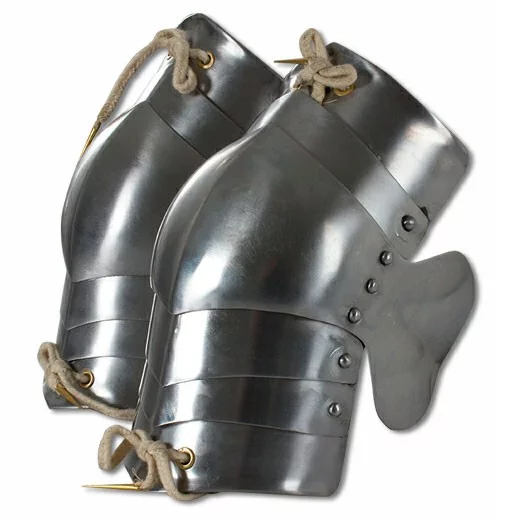
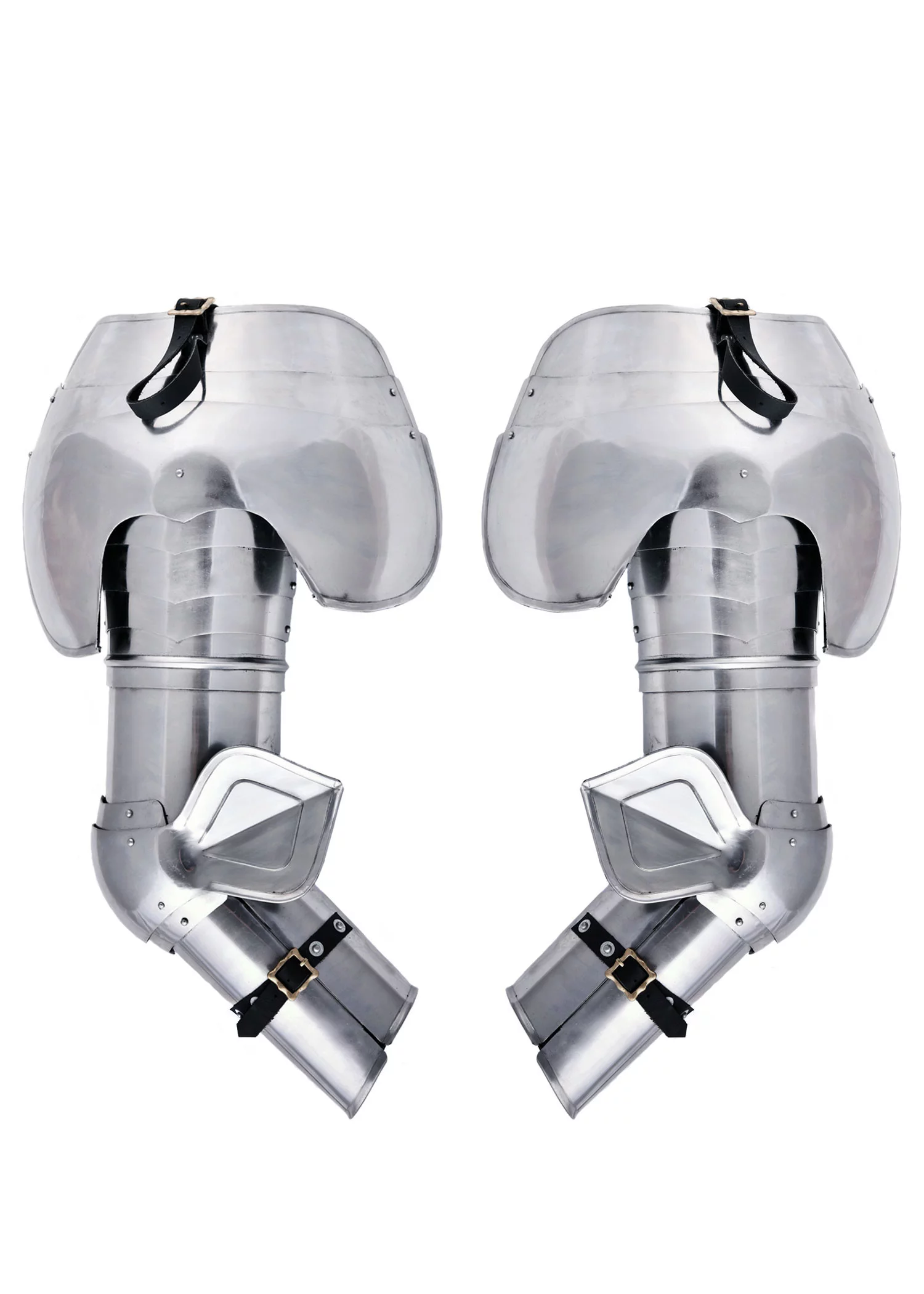
Codales are, without a doubt, a vital piece of medieval armor, intended to protect one of the most critical areas of the body during combat. Their evolution reflects not only advances in armory techniques but also a development in how warriors understood and valued personal protection.
Greaves are a key piece of medieval armor, playing a fundamental role in protecting the warrior's legs during combat. They provide security in one of the body's most vulnerable areas. Below are their characteristics, functions, materials, and historical evolution.
Characteristics of Greaves
- Coverage: They are designed to protect the front and sides of the legs, covering from the knee to the ankle.
- Material: Commonly made of metal, especially steel or iron, although other materials were also used.
- Design: They can be made in one piece or articulated, allowing greater mobility for the warrior.
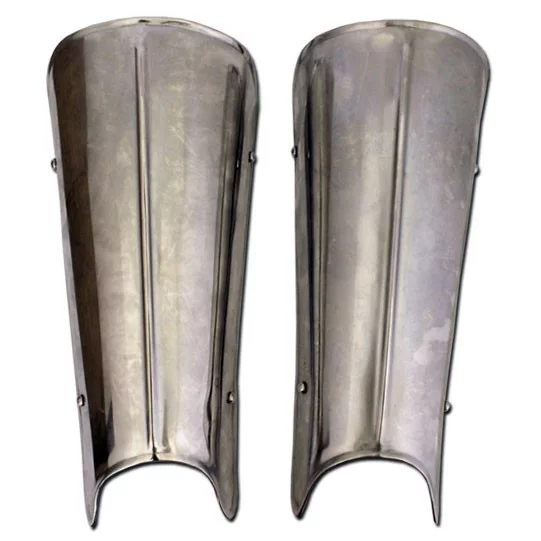
Types of Greaves
- Half Greaves: Some versions feature articulated half greaves that protect the lower part of the knees.
- Grebettes: These were specific pieces designed to protect the calves.
Functions of Greaves
- They protect against cuts and blows aimed at the legs.
- They defend against attacks from short weapons in close combat.
- They provide additional stability to the warrior during combat.
Historical Evolution
- Origin: Greaves have a long history, dating back to ancient Rome.
- Greaves in Rome: Hastati, heavy infantry soldiers, typically wore greaves on their right leg, which was advanced in combat.
- Middle Ages: Their design was refined, becoming an essential part of full plate armor.
Materials Used in Greaves
- Metal:
- Iron: The most common material for making greaves during the late Middle Ages.
- Steel: Used for more resistant and durable productions.
- Bronze: Employed in ancient times, modeled after Etruscan greaves.
- Leather:
- Hardened leather: Frequently used as a lighter alternative to metal.
- Boiled leather: This treatment increased the hardness of the leather, making it more resistant to impacts.
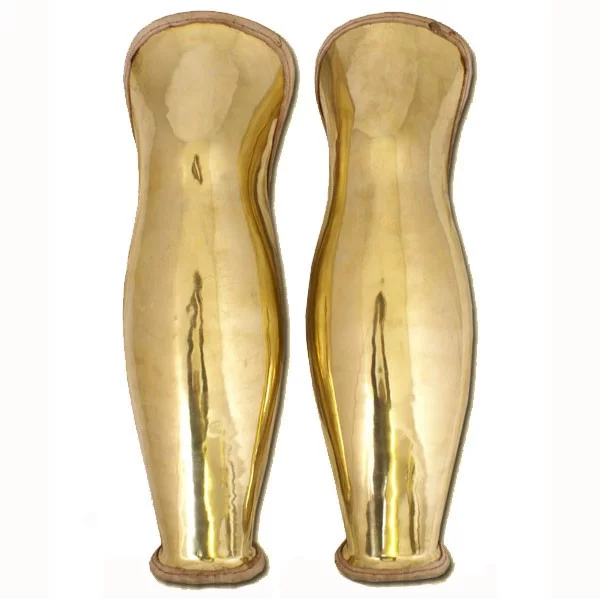
In summary, greaves offer a combination of protection and functionality that has endured throughout history, adapting to the needs of warriors and advances in weaponry and combat techniques. Their importance in medieval armor makes them a key piece for understanding the evolution of protection in warfare.
The aiglets, also known as agelets, are small yet significant accessories that have their roots in historical clothing, especially in outfits from periods such as the medieval and Renaissance eras. Their main function is to secure the laces on garments like doublets and gambesons, providing both functionality and an aesthetic touch to the attire.
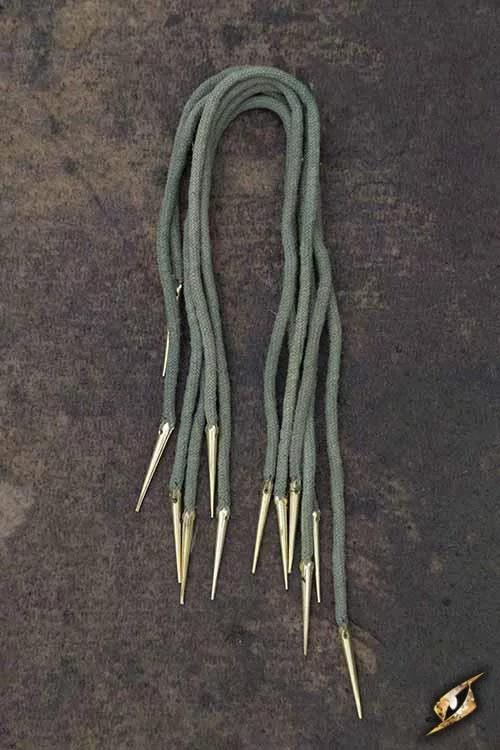
Characteristics of Aiglets
- Materials: Often, aiglets are made of metal, with brass being one of the most common materials due to its durability and authentic appearance. Solid brass aiglets are particularly popular among historical reenactment enthusiasts, as they offer superior quality that resembles the originals.
- Size: The size of aiglets can vary, although it is common to find models that measure approximately 3.8 cm. This size is ideal for use in various historical garments.
- Style: Beyond their practical utility, aiglets also add a decorative element to clothing. They are crucial for achieving an authentic look in historical reenactments, theater, or themed costumes. Their design can range from simple to elaborately ornate, allowing for personal expression within historical contexts.
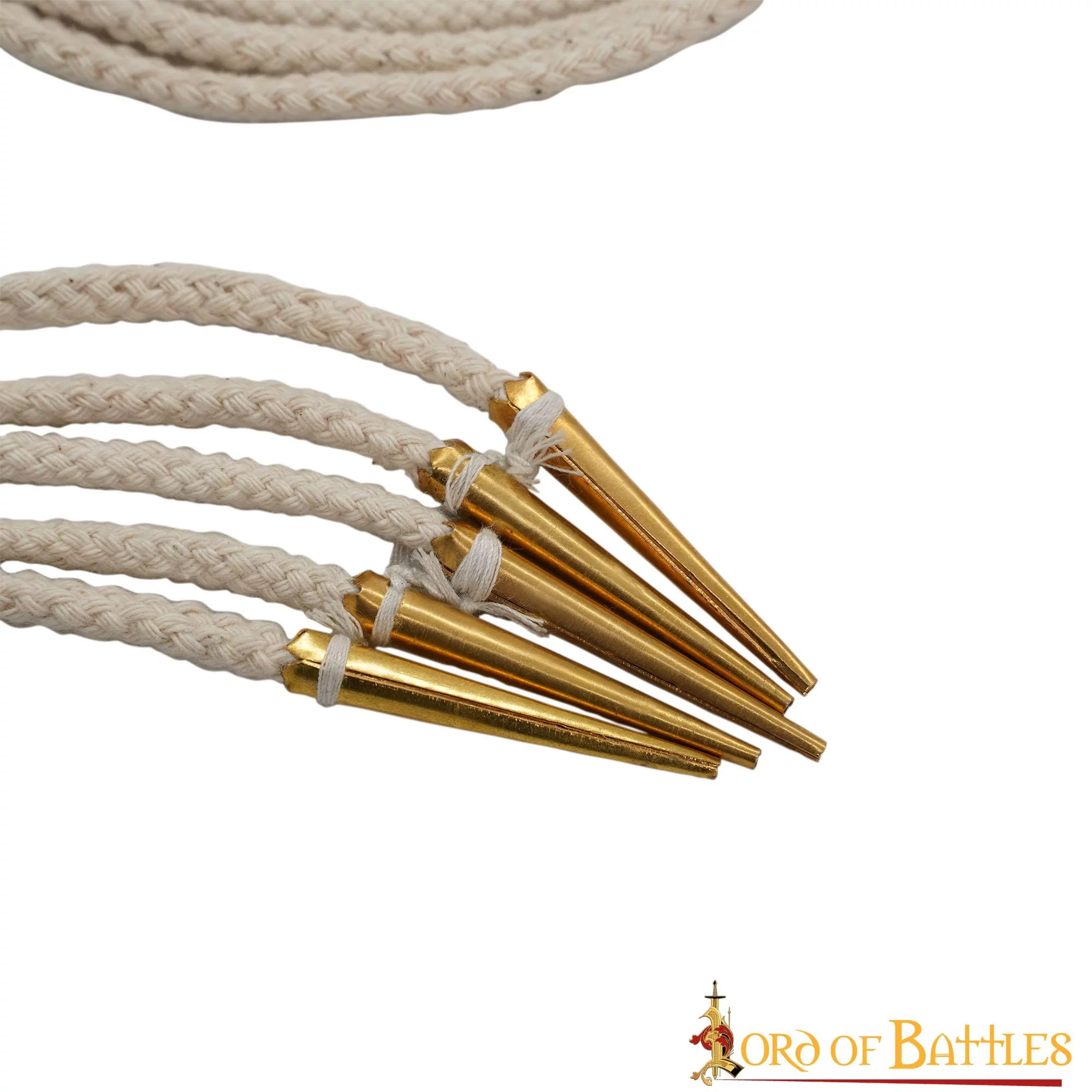
In summary, aiglets are more than just simple accessories; they are essential elements that contribute to the authenticity and aesthetics of historical clothing. Their proper use not only enhances the functionality of garments but also allows for a journey through time via the fashion of past eras.
The Roman galea is an emblematic helmet that was an essential part of the military equipment of Roman legionaries during the times of the Republic and the Empire. Its ingenious design was not only aimed at providing protection on the battlefield but also symbolized the pride and discipline of the Roman armed forces.
Origin and Characteristics of the Roman Galea
Used since the 4th century BC and evolving over time, the galea replaced earlier helmets like the Montefortino and the Coolus. Its most distinctive feature is that, unlike other helmets, such as the cassis which was made of metal, the galea was commonly made from leather, offering a balance between protection and comfort.
Essential Design
- Structure: The galea featured an elongated shape that tapered towards the top, improving the soldier's aerodynamics and vision.
- Materials: Although it included leather, some models were made in bronze or iron, especially during the imperial period, providing more resistance and security.
- Refined Protection: Many galeas had reinforcements to protect the cheeks and neck, allowing legionaries to better face the risks of combat.
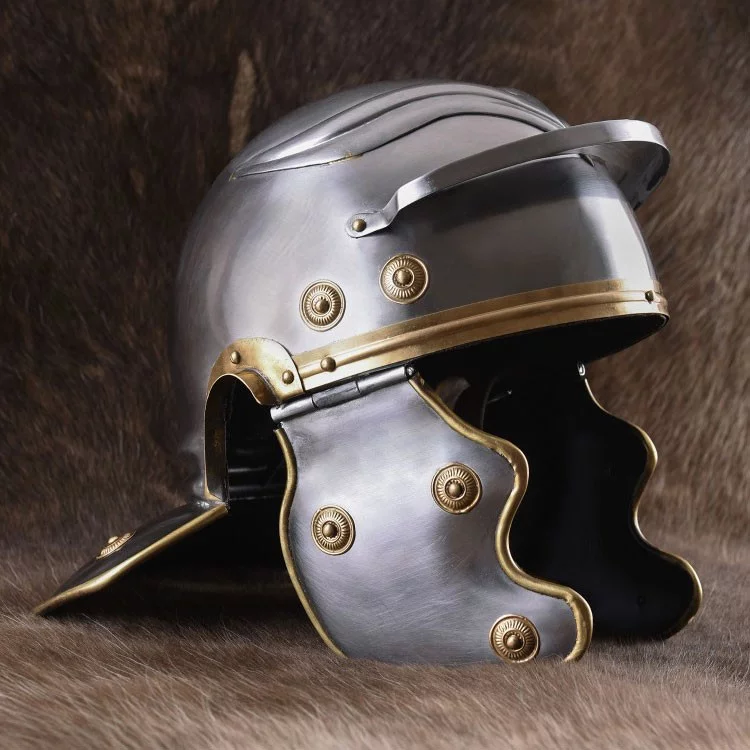
The Galea in the Roman Military Context
The use of the galea was common among legionaries, who understood that their effectiveness in combat was closely related to the equipment they carried. This helmet not only provided protection but also helped identify ranks and roles within the military unit.
Identification and Symbology
- Sign of Rank: The different variants of the galea allowed distinguishing between soldiers, officers, and different units, creating order within the battlefield.
- Tactical Evolution: Over time, the design of the galea adapted to new tactics and technologies, demonstrating the constant innovation of the Roman army.
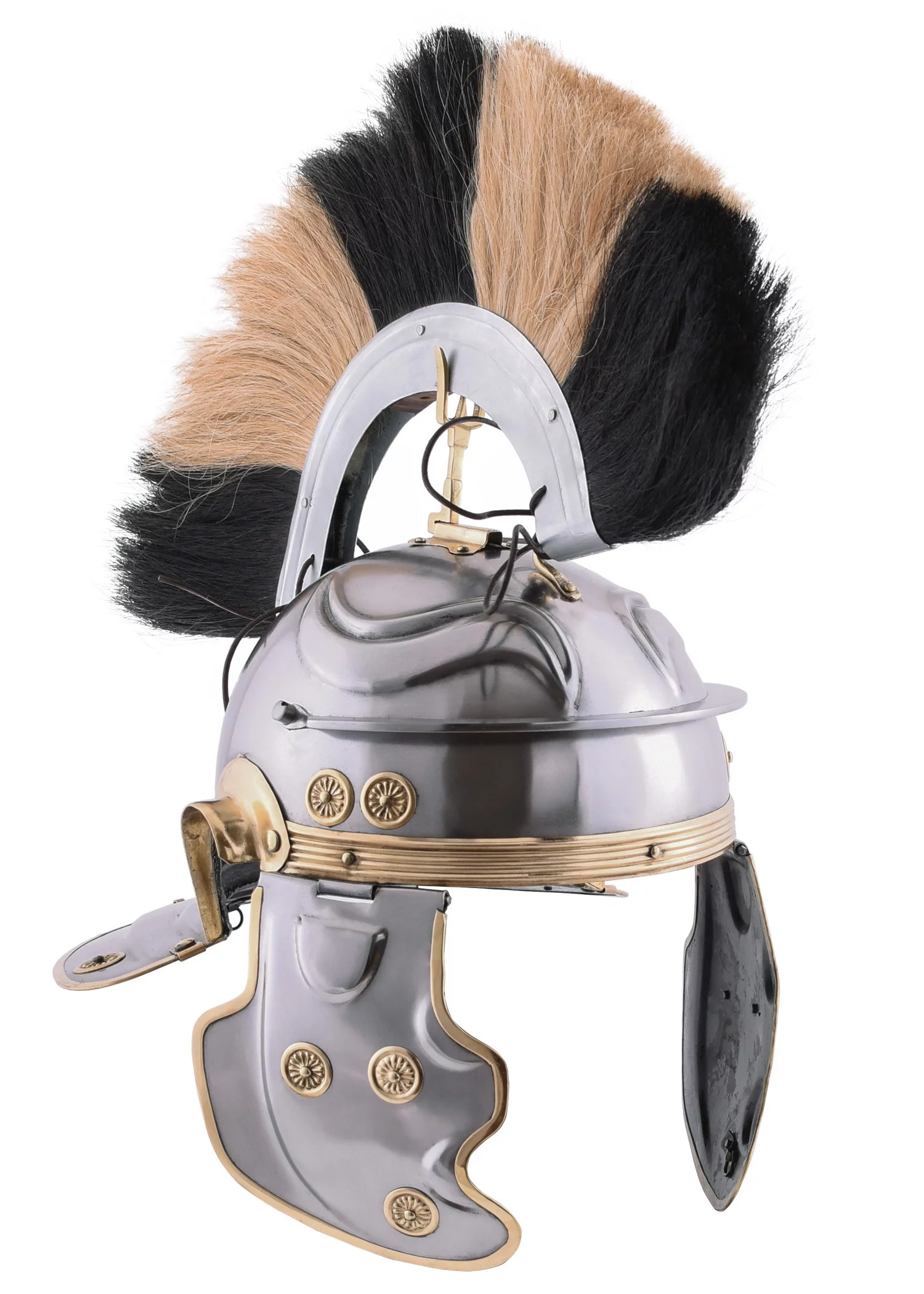
A Lasting Legacy
The Roman galea is a symbol of the military ingenuity and discipline of the Roman army. Its design and evolution reflect not only the need for protection but also the complexity of combat tactics of the era. This helmet represents a fascinating chapter in military history, showing how Roman armor adapted over time to face the challenges of a constantly changing world.
| Type of Galea | Material | Additional Protection | Use |
| Leather Galea | Leather | Limited | Republican Legionaries |
| Bronze Galea | Bronze | Cheeks and neck | Imperial Legionaries |
| Iron Galea | Iron | Complete | War and advanced protection |
The Roman Subarmalis is a historical garment that played a vital role in the clothing and protection of soldiers during the Roman Empire and the Byzantine Empire. This innovative piece of armor not only offered comfort but also provided crucial defense on the battlefield.
Origin and History
The design of the Subarmalis is inspired by more primitive versions used by Greek peoples. Over time, the Romans made adjustments that optimized its functionality and comfort, making it an essential element of the Roman military arsenal.
Features of the Subarmalis
- Materials: Generally made of treated leather or padded fabrics, the Subarmalis offered durability and impact resistance.
- Design: It featured laces or fastenings that allowed for a tight fit to the body, ensuring that the garment did not move during combat.
- Layers of Protection: It was strategically placed under armor, such as the lorica hamata (chain mail) or the lorica segmentata, providing additional defense against blows and bruises.
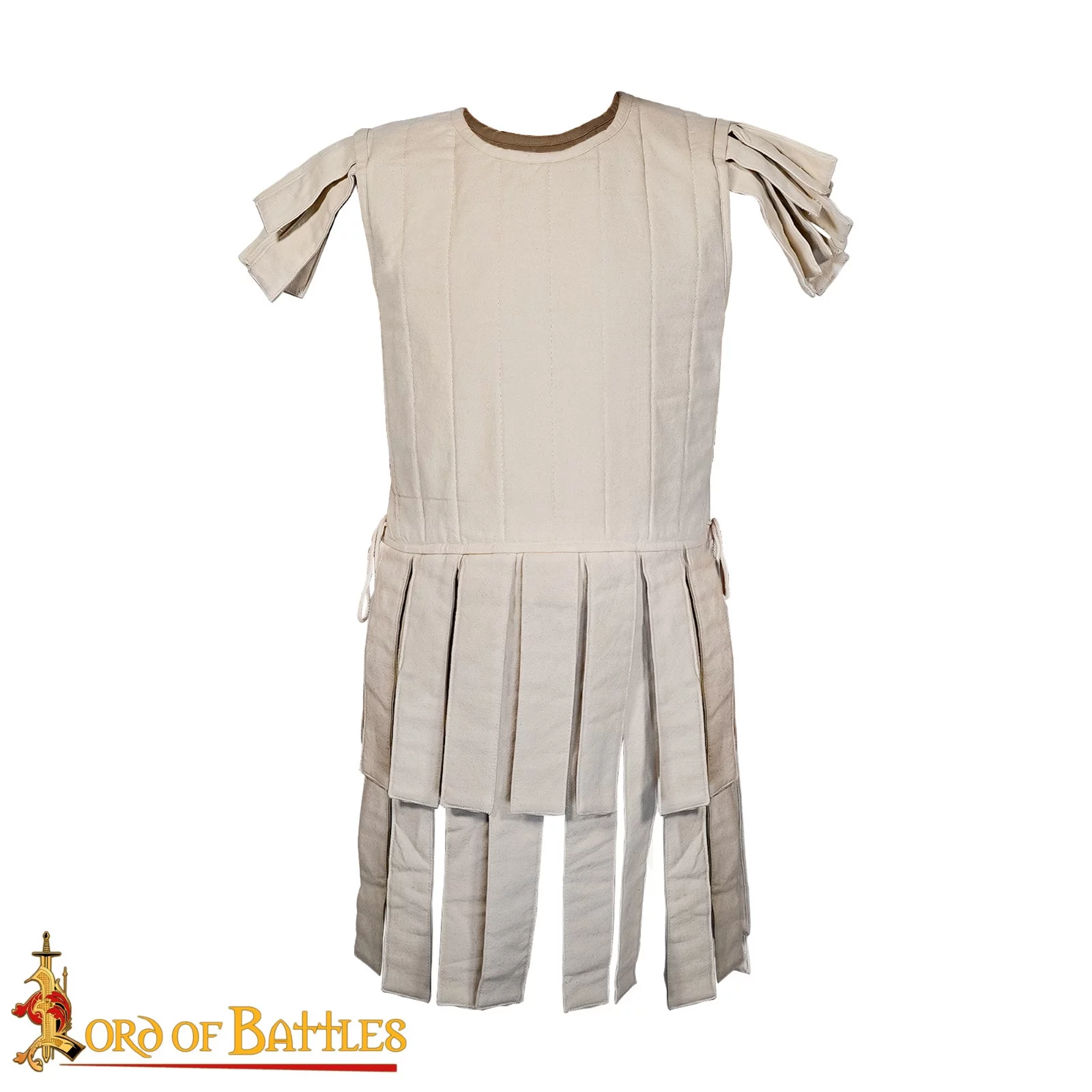
Use on the Battlefield
The Subarmalis was commonly used by both Roman and Byzantine troops and was considered indispensable for any soldier equipped with armor. Its main function was:
- Cushioning the impact of enemy weapons, especially in hand-to-hand combat.
- Protecting the soldier's torso and limbs, reducing the risk of serious injuries.
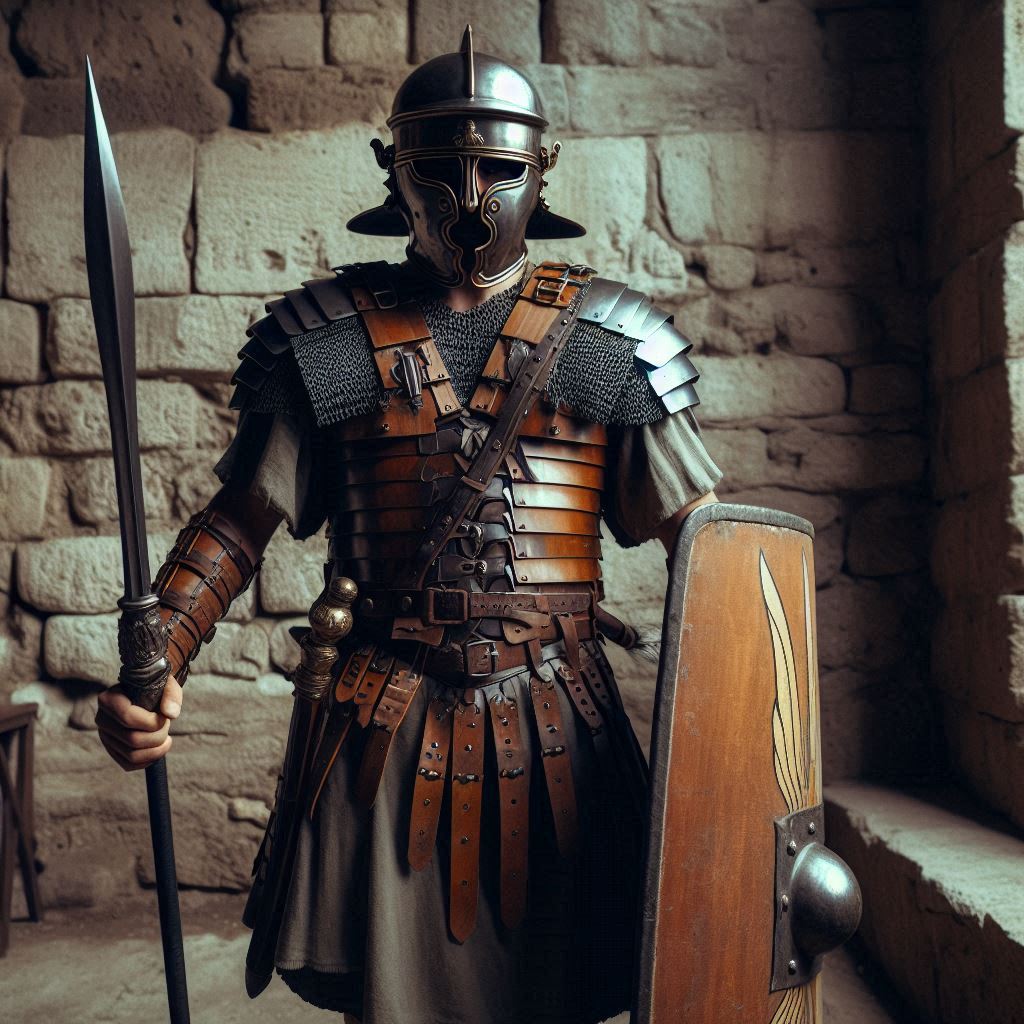
Impact on Military History
The utility of the Roman Subarmalis paved the way for the evolution of military garments. Its design not only benefited the soldiers in their performance but also laid the foundations for future innovations in personal protection. The legacy of this garment can be seen in the ongoing research and historical reenactment carried out by reenactor groups and academics, highlighting its importance over the centuries.
| Aspect | Description |
|---|---|
| Origin | Ancient Greek cultures, perfected by the Romans |
| Material | Treated leather and padded fabrics |
| Main function | Cushioning blows and protecting the soldier's body |
The escarcelas, also known as tassets, are distinctive elements of medieval armor that have captured the attention of historians and cultural heritage enthusiasts. Derived from the Italian term scarsella, these pieces, which flourished in the 14th and 15th centuries, have been recognized for their functionality and detailed artistic design.
Function of Escarcelas
The escarcelas were vital in protecting the knight in combat. Suspended from the belt and attached to the breastplate's fauld by straps and buckles, they covered the vulnerable gap between the breastplate and the cuisses. In this way, they safeguarded the groin, one of the most exposed areas to attacks on the battlefield.

Details and Evolution of Escarcelas
- Main Characteristics:
- They generally had a tile shape with vertical edges, offering suitable aesthetics and functionality.
- They were used symmetrically, although in some armors the right tasset could be shorter to facilitate horseback riding.
- Historical Evolution:
- Initially, they were fixed to the fauld, but they evolved to offer more mobility using straps.
- In the 15th century, the incorporation of Gothic designs allowed curved and radiated edges, improving their appearance.
- From the 16th century, an articulated version was created that provided knights greater freedom of movement.

Design and Materials in Escarcelas
- Design Variations:
- In armor for foot combat, it is common to see additional tassets that protect the coccyx.
- Some 15th-century armors incorporated small tassets on the sides for greater coverage.
- French armors before 1470 were of equal size, creating an effect similar to a plate skirt.
- Materials Used:
- Mainly metal, made of strong steel up to 1.2 mm thick, ensuring protection without sacrificing mobility.
- Leather was a popular alternative in historical reenactments and role-playing games, providing a lighter option.
Cultural Importance and Legacy
The escarcelas not only were fundamental in the physical protection of knights but also reflect a rich artisanal culture. They are a testament to the human ingenuity of the time, where functionality joined aesthetics, capturing the splendor of an era marked by chivalry and war. Their legacy continues to be an object of study and appreciation today, fascinating those who explore the history of medieval armor.
The helm is one of the most emblematic components of medieval armor, designed to provide vital protection to the warrior's head and face in battles and tournaments. The history of the helm is rich and varied, reflecting the evolution of combat technology and the art of metallurgy over the centuries.
History and Evolution of the Helm
From its beginnings, the helm has been fundamental in the evolution of armor. The earliest helms, which appeared thousands of years ago, offered basic protection. However, as more advanced manufacturing techniques developed, helms began to include decorative details and specific features to improve defense and comfort.
Helm Design
The design of the helm varied greatly over time:
- Initial Style: The earliest helms were simple; often flat and unornamented.
- Advanced Features: Over time, blacksmiths began incorporating elements like crests to deflect impacts and movable visors to enhance visibility.
Types of Helms
There are several types of helms, each suitable for specific contexts and fighting styles:
- Great Helm: Completely covers the head and face, with slots for vision. It was commonly used in the early Middle Ages.
- Basinet Helm: Provides comprehensive protection, with movable visors that improve visibility. Popularized in the 14th and 15th centuries.
- Nasal Helm: Known for its lightweight design, but offers less protection compared to other types, leaving part of the face exposed.
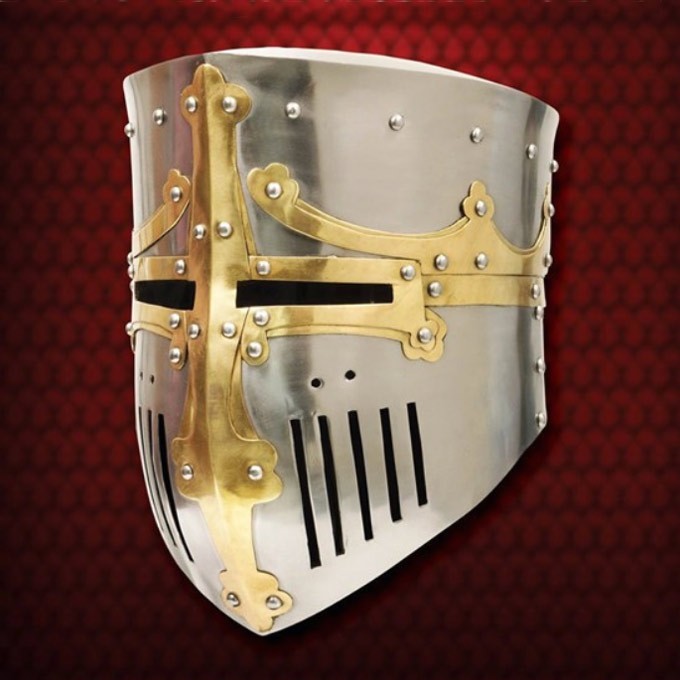
Function of the Helm in Battle
The helm not only serves to protect; it was also designed to terrify the enemy. Many helms featured ornaments resembling animal heads or had threatening styles, increasing intimidation on the battlefield.
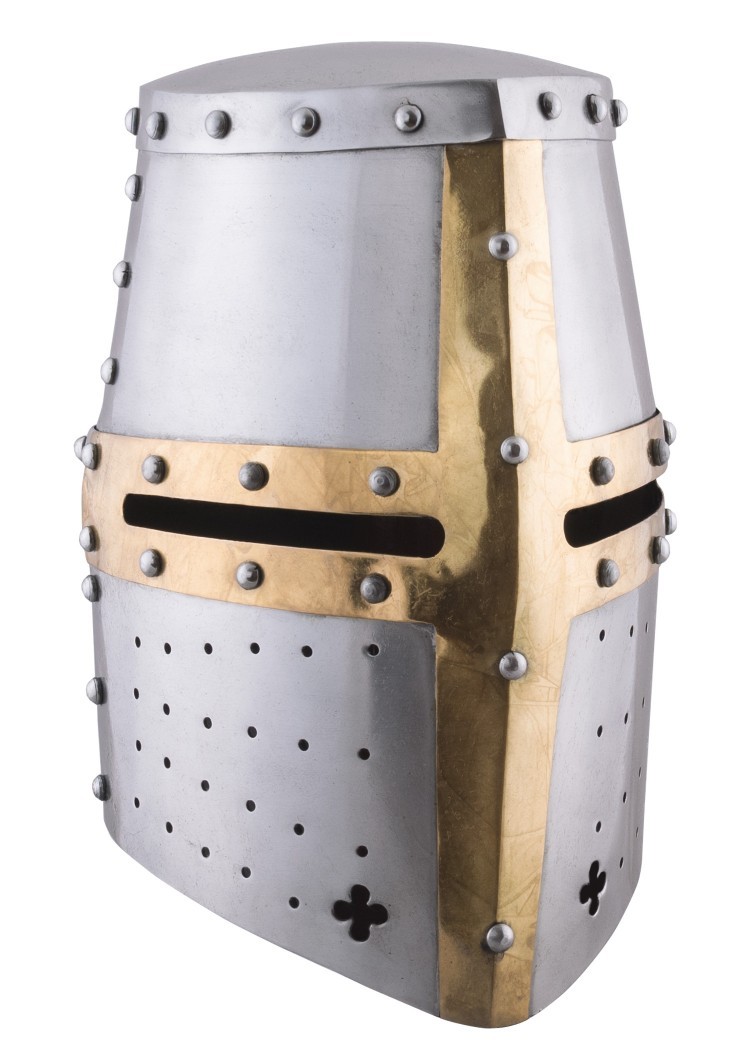
The Helm in Culture and Fiction
Beyond its role in war, the helm has found its way into mythology and literature. In Greek mythology, the helm of invisibility is mentioned, while in "Don Quixote," there is a reference to the famous helm of Mambrino, which turns out to be a simple basin.
| Type of Helm | Main Characteristics | Period of Use |
|---|---|---|
| Great Helm | Covers the head and has vision slots | Early Middle Ages |
| Basinet Helm | Movable visors and full protection | 14th and 15th centuries |
| Nasal Helm | Lightweight design that leaves part of the face exposed | Various periods |
Origin and Characteristics of the Bascinet
The term "bascinet" comes from the Latin *bacinetum*. Some believe its name is related to its resemblance to a basin or container. This helmet emerged as a revolutionary option against the heavy helms of the time, providing lighter and more practical protection for the medieval warrior.- Initial Design: The bascinet had a hemispherical shape covering the head, ears, and neck, offering protection without sacrificing mobility.
- Evolution: Over time, some models adopted a pointed design at the top, while the addition of visors improved facial defense.
- Options: It could be found with or without a visor, depending on the historical period and region in which it was used.
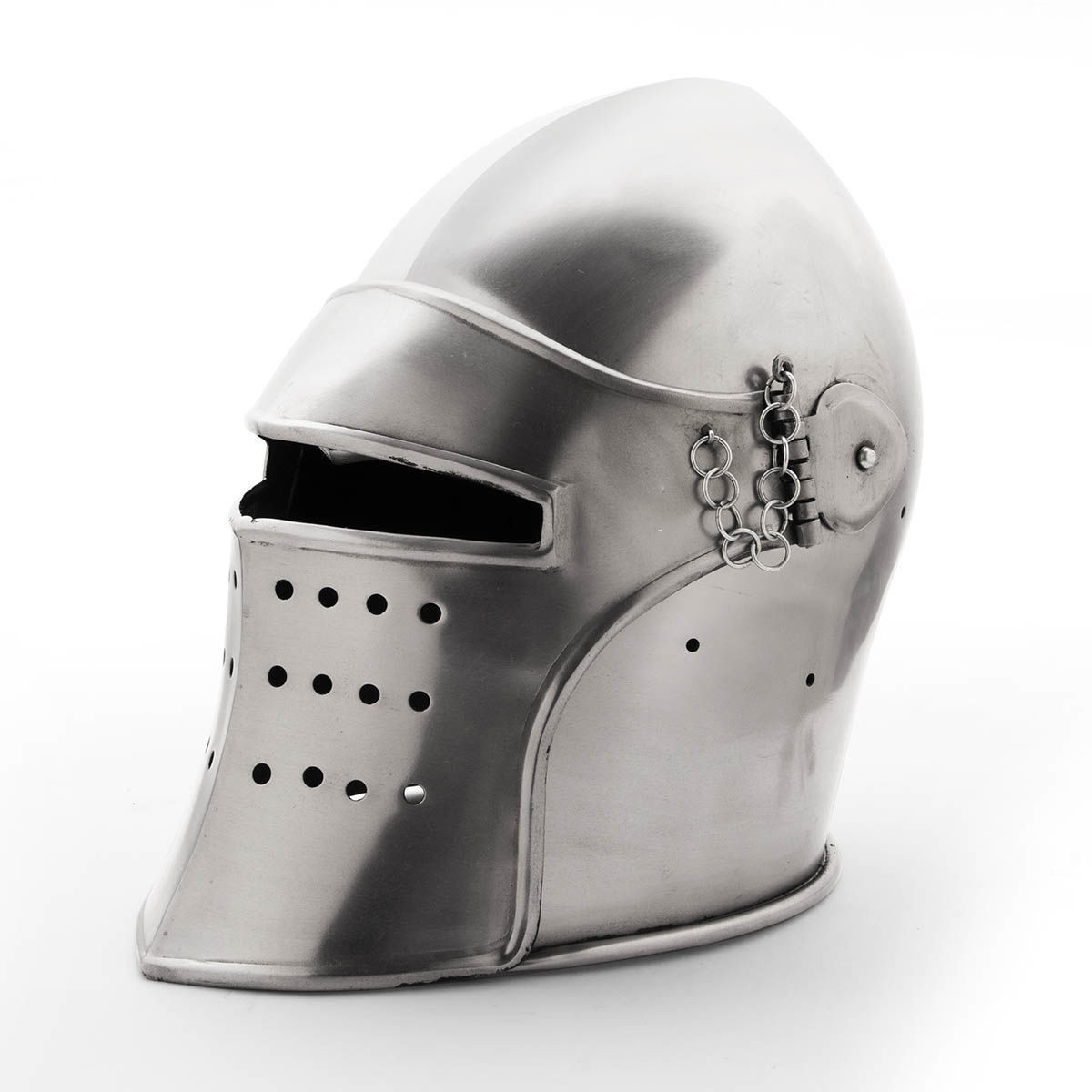
The Role of the Bascinet in Combat
Initially, the bascinet was used as an extra layer of protection under the helm, as complete helms were uncomfortable and too heavy for long combat periods. This circumstance motivated soldiers to replace the helm with the bascinet by removing the former.Main Stages of Its Evolution:
1. **Implementation of the Visor:** In the 14th century, to protect the exposed face, movable visors began to be added. These evolved from simple options, such as a "movable trap" around 1310, to more sophisticated designs with a conical shape around 1350. 2. **Structural Improvements:** From 1380, the design of the bascinet expanded its protection to include shoulder support. At this stage, visors adopted a more hemispherical shape instead of a conical one. This final design offered more comfort and defense in combat.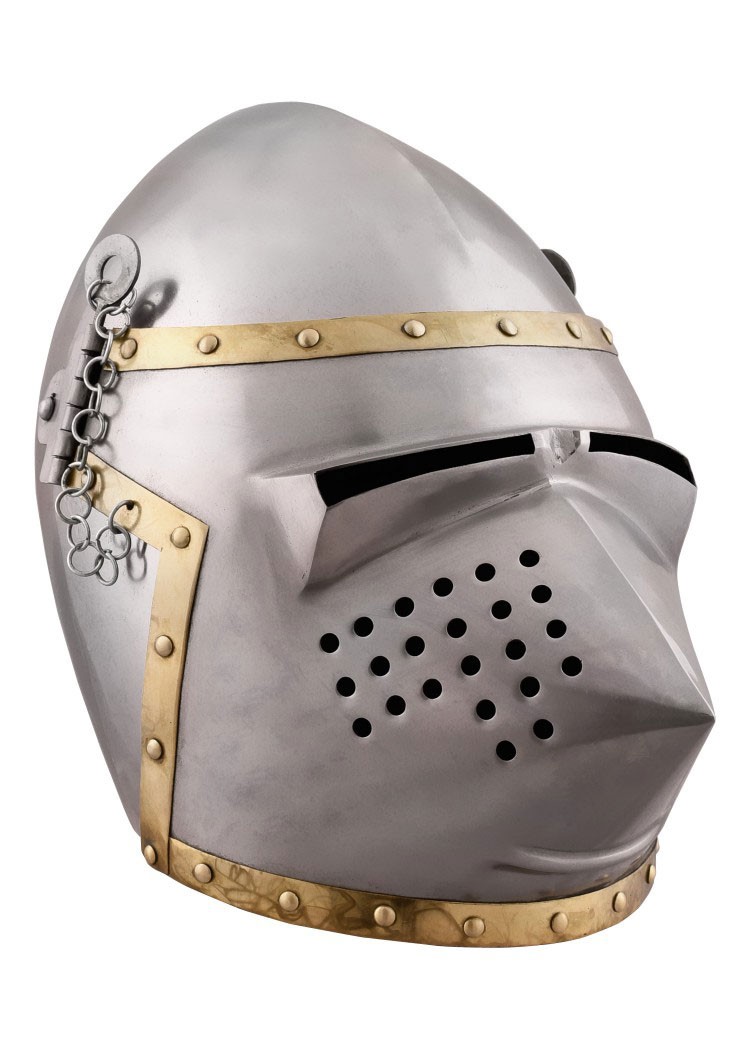
Regional Diversity and Types of Bascinets
The popularity of the bascinet spread throughout Europe, adopting variations according to local needs:- Spain: Here the bascinet usually had an ovoid and pointed shape, with a flat visor. It is celebrated in historical documents like the codex of the Trojan War (14th century).
- Bascinet with Nasal: This older model incorporates an extension to protect the nose and was particularly common in the Iberian Peninsula.
- German Models: Reinforced bascinets known as "embattlement" were developed, widely used by German soldiers.
The Legacy of the Bascinet
The bascinet was not only a protection tool but also marked a significant transition in medieval armor design. Its evolution demonstrates how technological advances and battlefield needs shaped military equipment. With its adaptable design, regional variations, and multiple variants, the bascinet continues to be a subject of study and fascination for those interested in military history and culture.| Period | Design Characteristics | Main Regions |
|---|---|---|
| Late 13th Century | Hemispherical shape, no visor | Western Europe |
| 1350 | Added conical visor | France, England |
| 1380 | Expanded design to the shoulders | Germany, Spain |
The history and evolution of medieval armor allow us to glimpse an era where survival on the battlefield depended as much on the warrior's skill as on the effectiveness of their protection. In this context, plate armor and chainmail emerged as two of the most prominent options. Each offered unique advantages and limitations that directly influenced combat tactics. It is worth exploring these differences in depth to understand why both were fundamental in their time.
Plate Armor: Strength and Modernity
Plate armor, also known as full metal armor, represented a significant advance in personal protection during the height of the Middle Ages, approximately from the 14th century. This equipment consisted of steel plates strategically assembled to cover vital areas of the body, such as the chest, abdomen, arms, and legs.
- Material and construction: Usually made of steel, a metal that offered high resistance to blunt and cutting attacks. The pieces were joined using rivets and leather straps, providing the warrior with a certain degree of mobility.
- Effectiveness against weapons: It offered a superior level of protection, especially against blows from maces or swords. The plates distributed the impact of blunt weapons over a wider surface, reducing the risk of severe fractures.
- Limitations: Its main drawback was the weight, which ranged between 20 and 25 kg, requiring significant physical training from its wearer. Additionally, its rigidity could limit certain agile movements on the battlefield.
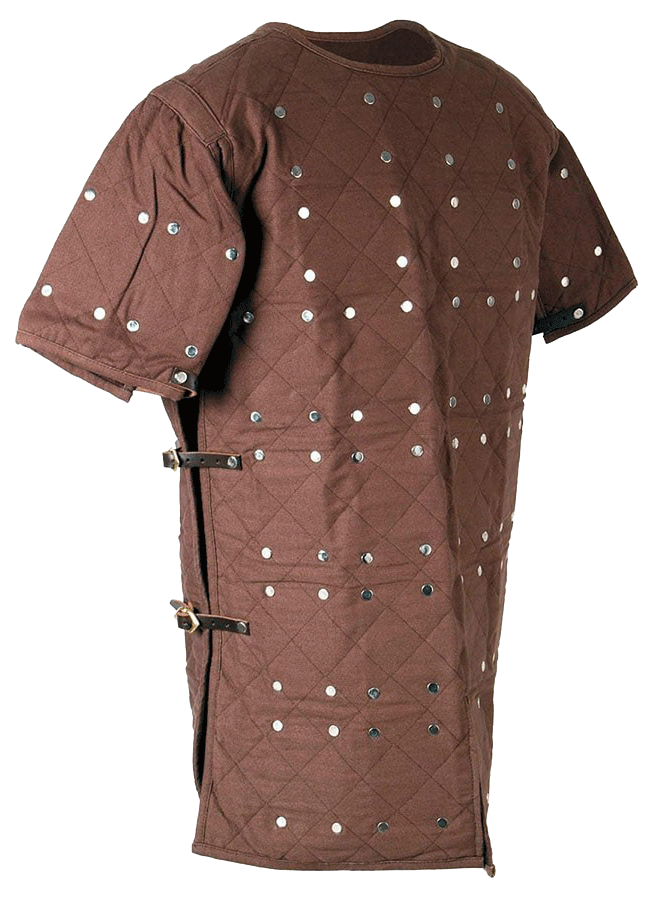
Chainmail: Flexibility and Versatility
Chainmail has much older origins, dating back several centuries before the Middle Ages. This type of armor was composed of small interlinked rings, usually made of steel or iron, designed to cover the torso and, in many cases, the arms, legs, and head.
- Material and construction: Its design allowed for great flexibility, as each ring was connected to four or six adjacent rings. This made it an excellent option for more agile combat.
- Effectiveness against weapons: It effectively protected against cuts and lacerations. However, it could not completely prevent damage from blunt weapons, such as war hammers or heavy projectiles that crushed the rings.
- Limitations: Although it was less restrictive in terms of mobility, chainmail could be penetrated by thrusting attacks, such as spears or crossbow bolts. Additionally, its weight, which ranged from 10-15 kg, was less evenly distributed and rested mainly on the shoulders, which could become uncomfortable over long periods.
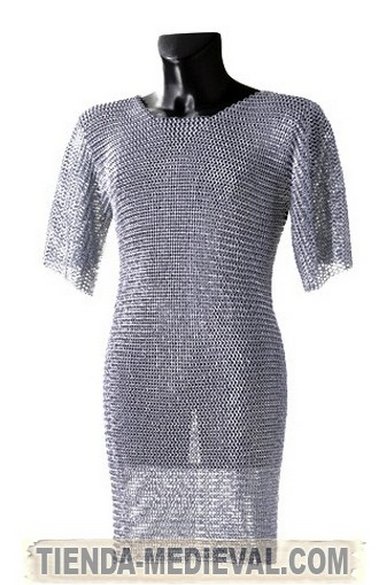
Key Comparison Between Plate Armor and Chainmail
While both armors were iconic in their respective eras, they differed significantly in terms of design, effectiveness, and purpose in combat. Below is a direct comparison:
| Aspect | Plate Armor | Chainmail |
| Protection | High against blows and cuts | Moderate, less effective against thrusts |
| Mobility | Moderate rigidity, greater in advanced models | High, allows for a wider range of movement |
| Weight | 20-25 kg (well distributed) | 10-15 kg (weight on shoulders) |
| Vulnerabilities | Specialized piercing weapons | Blunt weapons and projectiles |
Strategic Choice
The choice between plate armor or chainmail ultimately depended on the combat style and the prevailing threats on the battlefield. While plate armor offered greater protection against piercing and blunt weapons, chainmail excelled in flexibility and freedom of movement.
During the Middle Ages, the development of armor was vital for the protection of warriors on the battlefield. Among the most notable defensive elements, helmets played a fundamental role. In this article, we will explore a detailed comparison between two of the most iconic helmets of this era: the bascinet and the spangenhelm. We will analyze their characteristics, advantages, disadvantages, evolution, and the impact they left on history.
Design and Features
The Bascinet Helmet
The bascinet is easily recognizable due to its rounded shape and integral coverage, protecting both the head and neck of the warrior. This design stood out during the late medieval period for its combination of protection and mobility.
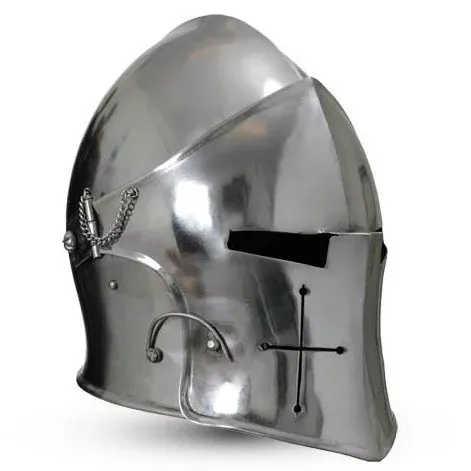
- Material: Made primarily of steel. Early versions were crafted from forged iron.
- Flip-up visor: Featured a mobile visor that allowed for adjusting protection levels as needed.
- Protection: Its structure fully covered the head and neck.
Advantages:
- Provided integral protection, significantly reducing damage from cuts and blows.
- Its compact design allowed for greater mobility compared to other closed helmets.
Disadvantages:
- Its visor could limit peripheral vision.
- The lack of ventilation could cause discomfort during prolonged combat.
- Heavier models led to fatigue after extended use.
The Spangenhelm Helmet
The spangenhelm, also known as the segmented helmet, gained popularity between the 6th and 11th centuries. Its modular design made it easier to construct, offering an economical and effective option.
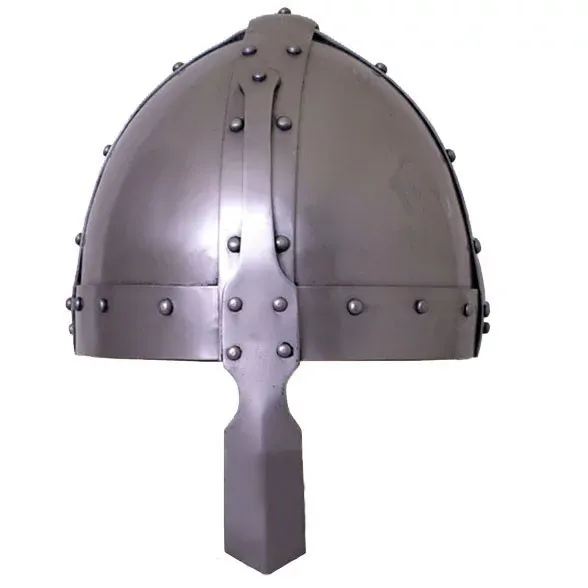
- Structure: Made up of metal strips joining various steel or bronze plates.
- Conical shape: Designed to deflect blows to the sides rather than absorb them directly.
- Options: Some models included nasal protection and cheek flaps made of metal or leather.
Advantages:
- Ease of manufacturing thanks to its segmented design.
- Offered additional protection options, such as nasal or ocular protection.
Disadvantages:
- Unlike the bascinet, it did not provide integral protection.
- The joints between segments made its structure more vulnerable at certain points.
Evolution and Historical Use
Bascinet
The bascinet was developed in response to the needs of infantry and cavalry, becoming a symbol of medieval armor from the 14th century onward. However, with the advent of more effective firearms, it lost relevance and was replaced by more robust closed helmets, like the cabasset, by the late 15th century.
Spangenhelm
The spangenhelm originated earlier, arriving in Western Europe through nomadic Iranian tribes like the Scythians and Sarmatians. It gained popularity during the Early Middle Ages until simpler designs, such as nasal helmets, became dominant.
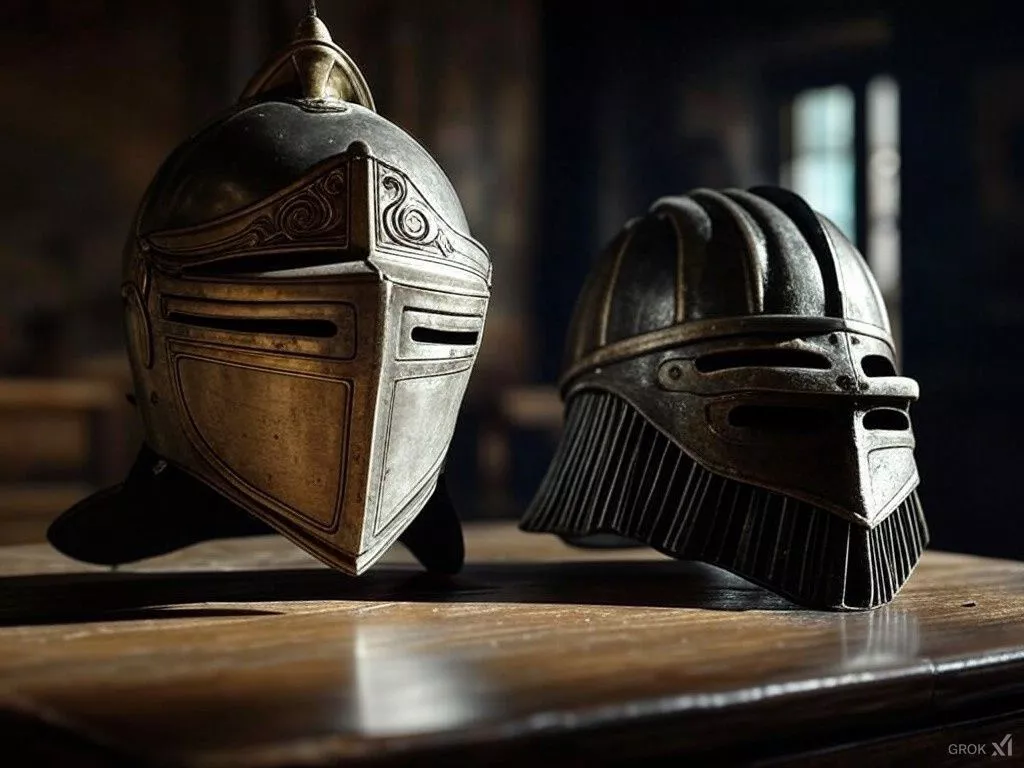
Legacy and Relevance
Bascinet
The bascinet's design laid the foundation for future military helmets. Its influence can still be traced in steel helmet models used during world wars. Moreover, its focus on balancing protection and mobility continues to be relevant in the modern production of protective equipment.
Spangenhelm
Although surpassed by other designs, the spangenhelm left its mark on military history. Its segmentation inspired later technologies in various cultures, showcasing its adaptability as a key feature.
| Features | Bascinet | Spangenhelm |
|---|---|---|
| Protection | Integral | Partial |
| Material | Steel | Steel or bronze |
| History | Late Period | Early Middle Ages |
Both the bascinet and the spangenhelm represent the ongoing evolution of military technology during the Middle Ages, each with its strengths and limitations. These helmets not only protected warriors of their time but also established a lasting legacy in the history of armor and military design.
The helmet is a military helmet used since the early years of the 15th century. Its design represented a significant evolution from earlier helmets, such as the bascinet, and was distinguished from the sallet by its specific characteristics. Aiming to provide more effective and functional protection on the battlefield, the helmet quickly established itself as an essential piece of armor for the fighters of the time.
Origin and Development
The helmet emerged in the region of Germany in the early 15th century, and its popularity quickly spread throughout Europe. It could be part of a complete suit of armor or used as independent head protection. One of the most characteristic elements of its design was the large rear flaps that offered effective protection for the nape, making it an ideal option for both knights and infantry troops.
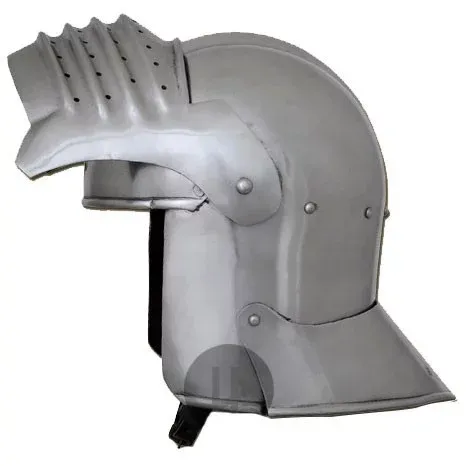
Characteristics of the Helmet
- Movable Visor: The helmet featured a movable visor that was attached to the sides of the helmet, leaving space for vision. However, this design risked allowing the entry of a spearhead through the opening.
- Articulated Nape Guard: Unlike the bascinet, which used mesh nape guards, the helmet was equipped with articulated steel plates, providing greater protection without restricting movement.
- Variety of Types: There were several types of helmets, including the barbute helmet, the gorget helmet, the infant helmet, the pavilion helmet, the morion helmet, and the Venetian or stradiot helmet.
- Decoration and Ornaments: The helmets of wealthy individuals were often richly decorated, featuring luxurious fittings and sometimes even horsehair padding.
Use in the Context of Warfare
Between 1450 and 1500, helmets became the preferred choice for head protection in combat. Their design, though simple, proved extremely effective, leading to their adoption by both knights and infantry troops. In addition to offering physical protection, the helmet had a significant psychological effect due to its "dehumanized" design, characteristic of mercenary troops.
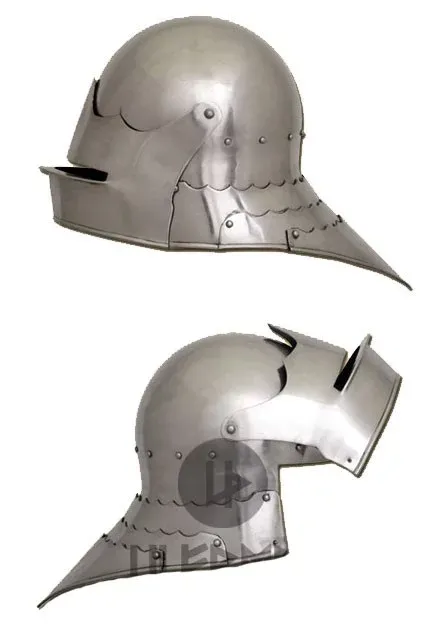
Historical Examples and Cultural Significance
Historical helmets are prized in museum collections, with designs dating mainly from the late 15th century. Many of these pieces feature perforated visors for improved breathing, combs, and chinstraps. In addition to their use in combat, they are mentioned in historical records as those used by the soldiers of King Alfonso V of Aragon and are represented in bas-reliefs on structures such as the arch in Naples dedicated to this monarch.
Ultimately, the helmet marked a milestone in the evolution of medieval armor, offering a balance between protection and mobility, and became a symbol of both military innovation and social status in its time.
The morion is a type of medieval helmet that played a significant role during the Modern Age, especially in the Kingdom of Castile and in other European countries between the 16th and 17th centuries. This emblematic helmet is not only a symbol of the rich military history but also represents the adaptation and evolution of the armors used by soldiers over time.
Origins and Description
The morion emerged as an evolution of the medieval cabe-p, taking inspiration specifically from the Kettle Hat. Its design is easily recognizable by its conical shape and its characteristic crest, similar to a sharp blade, that runs along the top. The wide wings that extend to the sides were crucial in providing additional protection to the neck and shoulders, deflecting impacts toward less vulnerable areas such as the nape and ears.
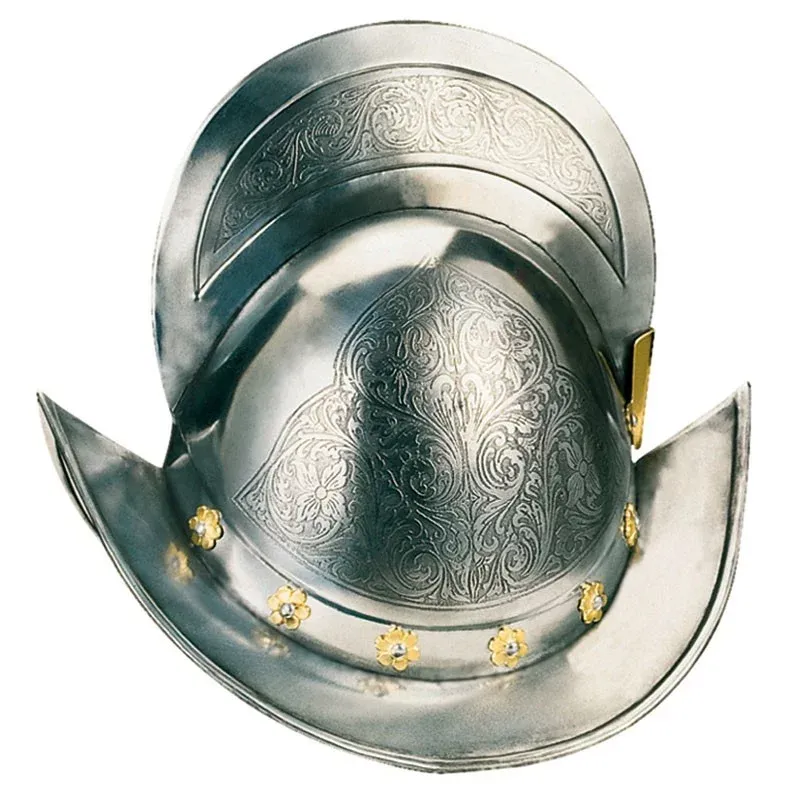
Use in Infantry
While the morion is predominantly associated with the Spanish tercios and the conquerors of America, its use was much broader. Infantry soldiers, commoners, and even knights and high-ranking figures preferred this type of helmet. Its lightness and ability to leave the face exposed facilitated breathing and improved visibility during combat. Within the Spanish tercios, it was common among pikemen and arquebusiers, although musketeers opted for the chambergo hat as an alternative.
Functional Characteristics
The design of the morion was not only aesthetically distinctive but also functional. Inside, the helmet was equipped with crossed straps that served to support the head, ensuring ventilation and cushioning against vertical impacts. A fabric lining on the inside provided comfort and allowed for a proper fit to different head sizes, while a chin strap kept the helmet secure during combat.
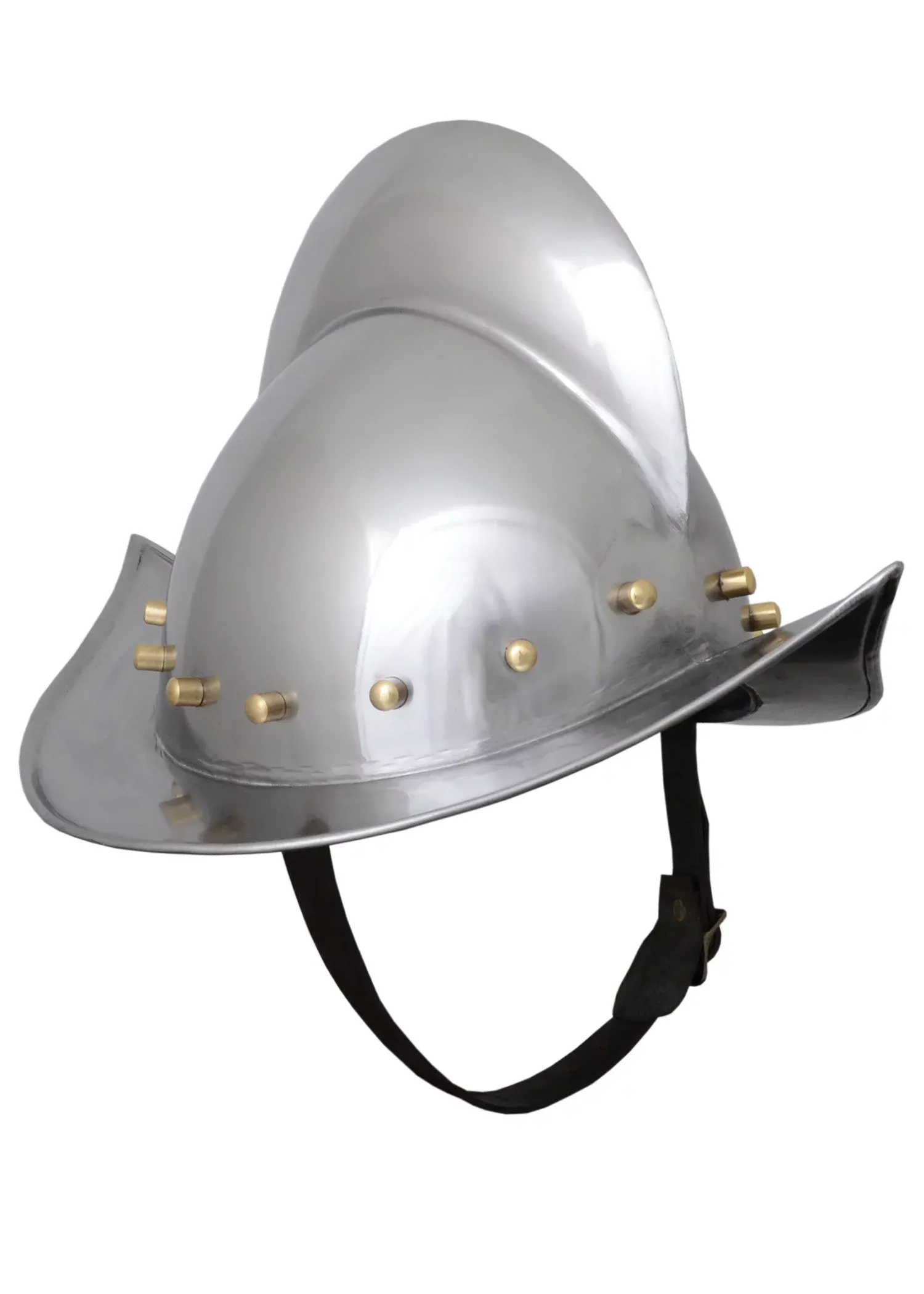
Use in Europe and America
The morion spread beyond Spanish borders, being adopted by numerous armies in Europe during the 16th and 17th centuries. It also had a presence on the American continent, as evidenced by pieces preserved in museums in North and South America. Despite its association with Spanish conquerors, its use was common among various military forces of the time.
Evolution and Disappearance
With the advancement of military technology and improvements in firearms towards the end of the 17th century, the morion gradually fell out of use. However, its name was revived in the late 19th century in Germany to describe a chapeau, which is a type of military hat without wings and with a visor.
Historical Legacy
Although the morion is no longer an essential element in the art of war, its legacy endures. It symbolizes the expansion and cultural influence of Spain in the world. Today, the morion remains part of the uniform of the Swiss Guard of the Vatican, and its design continues to be admired in replicas, historical recreations, and themed events.
| Key Aspects of the Morion | Description |
|---|---|
| Shape | Conical with a sharp crest and wide wings |
| Material | Mainly steel and iron |
| Function | Protection for infantry and light cavalry |
| Duration of Use | Popular in the 16th and 17th centuries |
| Regions of Use | Europe and America |
In summary, the morion is more than just a simple helmet. It is, without a doubt, a living testament to the history, culture, and military achievements of past times. Its design served not only a practical function but also told its own stories in the battles where it was a witness.
The **Loricata Segmentata** is an iconic armor of the Roman Empire, primarily used by legionaries during the High Empire, specifically between the 1st century BC and the 3rd century AD. Its design is characterized by being segmented, composed of individual metal plates connected through internal leather strips. This arrangement allows for greater flexibility and mobility for the soldier who wears it.
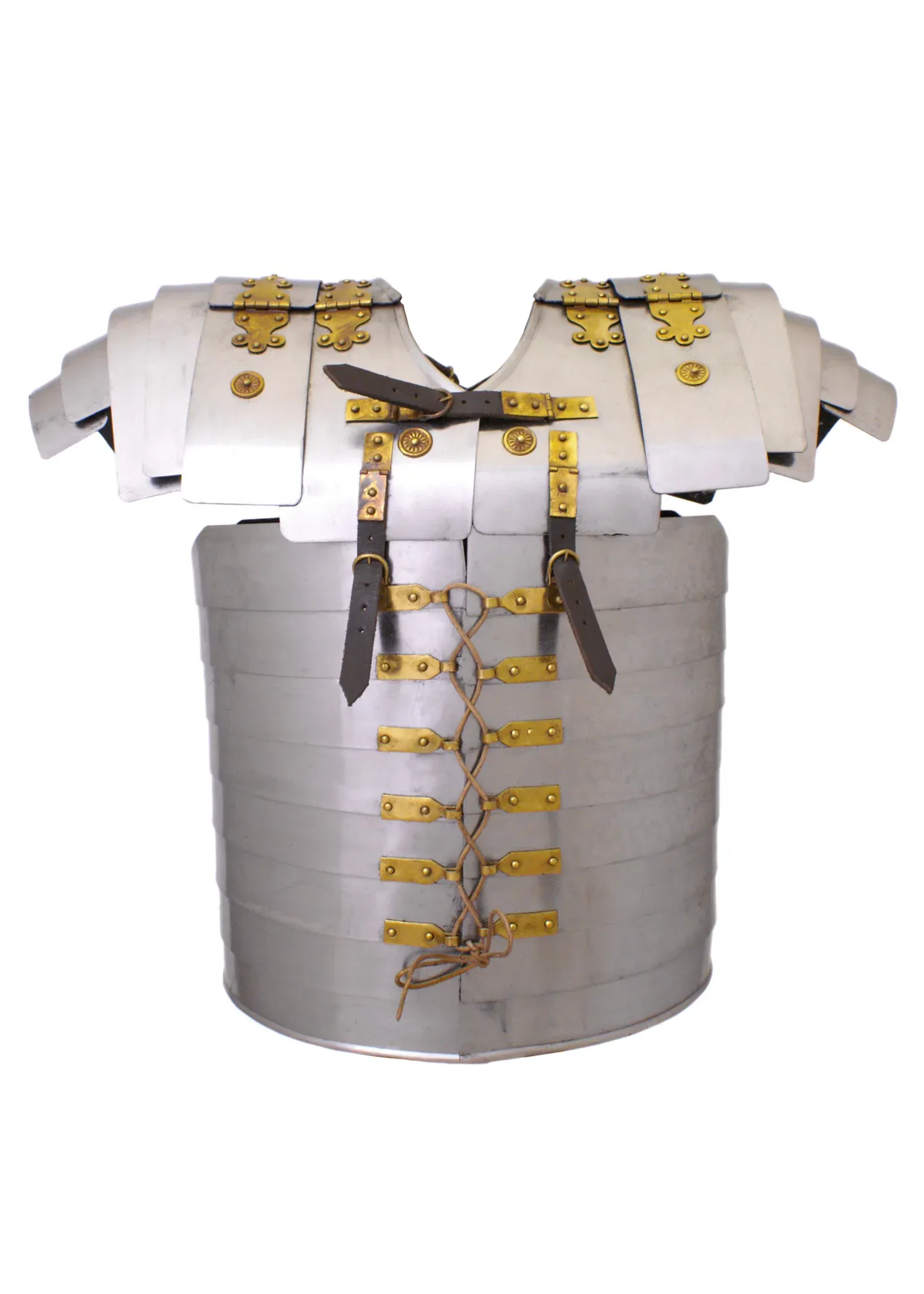
Description and Structure
The structure of the **Loricata Segmentata** is innovative for its time. It consists of metal bands, typically made of iron, that are placed horizontally across the chest and back of the soldier.
- These bands are joined by vertical leather straps, increasing mobility.
- It opens from one side, facilitating adjustment and removal.
Additionally, it features other vertical metal bands in the shoulder area, ensuring protection. Although the arms remain unprotected, the typical Roman formation minimizes their exposure.
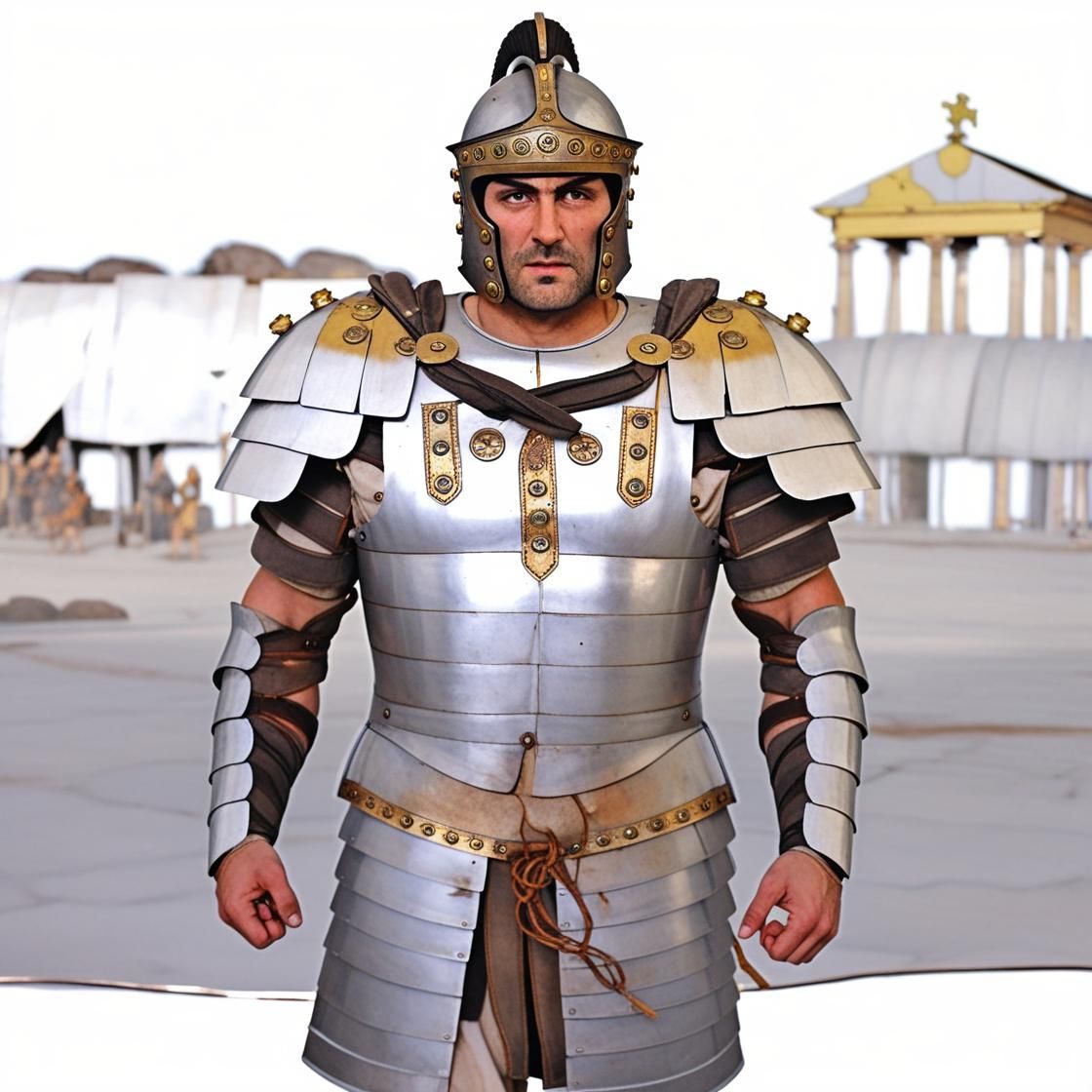
Evolution and Types
Over the centuries, the **Loricata Segmentata** evolved, adapting to the needs of combat:
- Loricata Segmentata Kalkriese: The most primitive type, used between 20 BC and 250 AD, even during the crucial Battle of Teutoburg.
- Loricata Segmentata Corbridge: Notable for the robust connection between the upper and lower parts via buckles and hooks, featuring large pectoral plates.
- Newstead: This variant increased the hinges at the shoulders, eliminating straps and further improving mobility.
Use and Advantages
The **Loricata Segmentata** was a distinctive feature of the Roman legionary and, occasionally, of the praetorians. However, auxiliary forces tended to use other armors such as **lorica hamata** (chainmail) or **lorica squamata** (scale armor).
The advantages of the **Loricata Segmentata** were significant:
- It provides superior protection compared to chainmail, although there are debates about the extent of its advantage.
- Mobility is one of its standout features, allowing the user to move freely in combat.
Disadvantages and Disappearance
Despite its benefits, the **Loricata Segmentata** had drawbacks that led to its disappearance:
- It requires a high level of skill for its manufacture, which significantly increases costs.
- The economic crises of the 2nd and 3rd centuries led to a shift towards more economical protection solutions like chainmail.
Iconography and Representation
The **Loricata Segmentata** has been immortalized in numerous historical reliefs. A famous example is its representation on the Trajan's Column, which depicts legionaries equipped with the Corbridge model. Although there may be variations for propagandistic reasons, these representations help us better understand its use and historical significance.
In conclusion, the **Loricata Segmentata** symbolizes the innovation and strength of the Roman army during a crucial period of its history. Its segmented design allowed for a unique combination of protection and mobility, although the complexity and cost of its manufacture limited its use to economically less conflictive periods.
The **Lorica Hamata** is an emblematic armor of ancient Rome, known for its extensive use in the Roman Legion during the periods of the Republic and Empire. This type of chainmail armor stands out for its flexibility and strength, being fundamental in the protection of Roman soldiers for centuries. With an innovative design based on Celtic techniques, the Lorica Hamata marked a milestone in the history of ancient armors.
Origin and Development
The origins of the **Lorica Hamata** can be traced back to ancient Celtic civilizations, where a primitive type of chainmail was adopted and improved by the Romans. The term "lorica" in Latin translates to "armor" or "breastplate," while "hamata" derives from "hamus," meaning "hook" or "chain." This armor became a fundamental part of Roman military equipment, reflecting both Celtic influence and the adaptability and evolution of Roman military technology.
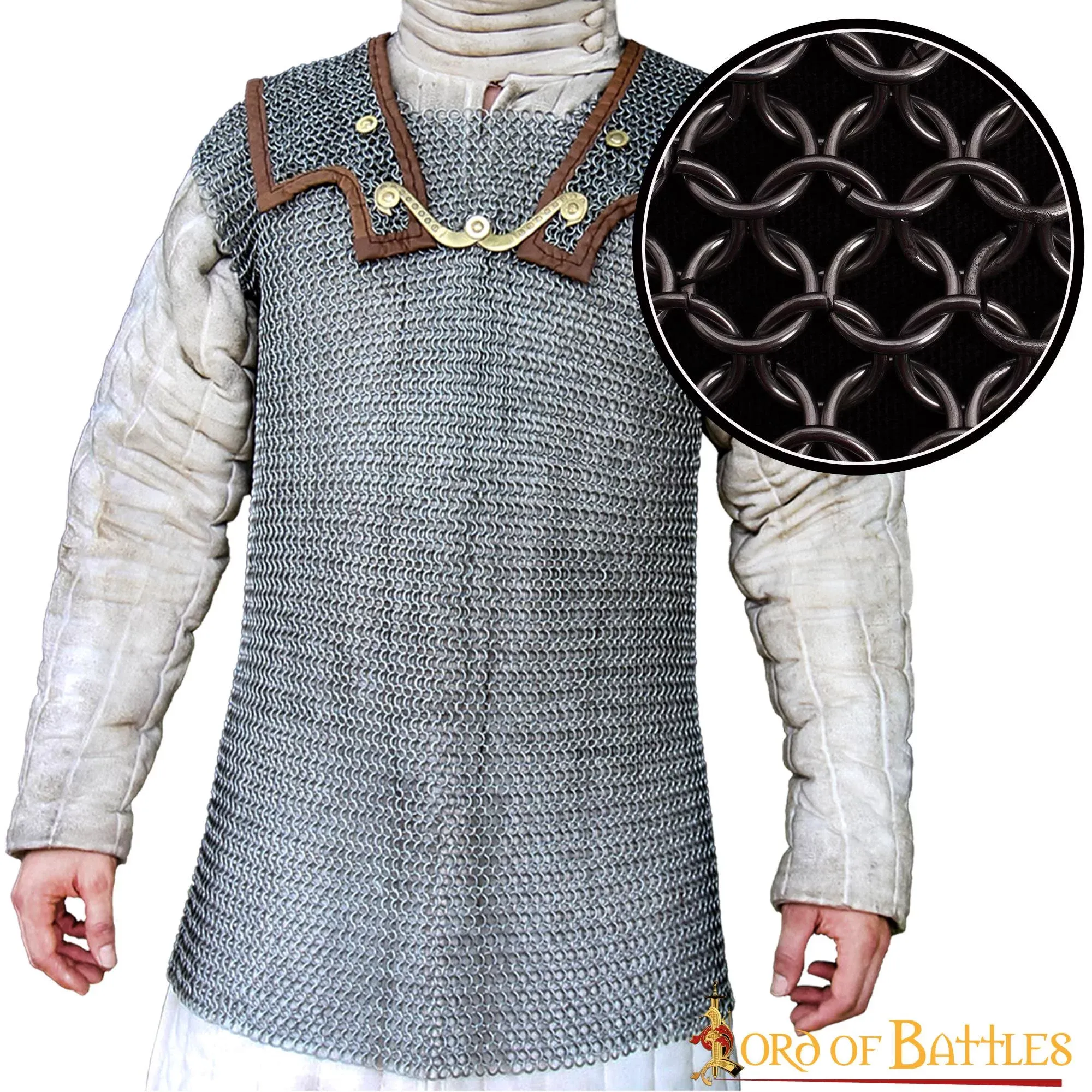
Main Features
- Construction: The **Lorica Hamata** was made up of small rings of bronze or iron, arranged in vertical and horizontal rows, all interlinked. Each ring had an internal diameter of approximately 5 mm and an external diameter of 7 mm, providing great flexibility and strength.
- Shoulder Protection: The shoulder pauldrons used a design similar to that of the Greek **Linothorax**, covering from the mid-back to the front of the torso, connected by metal fasteners.
- Versatility: Adapted for different types of troops such as scouts, cavalry, or spearmen, the Lorica Hamata offered customized protection according to the military activity of each soldier.
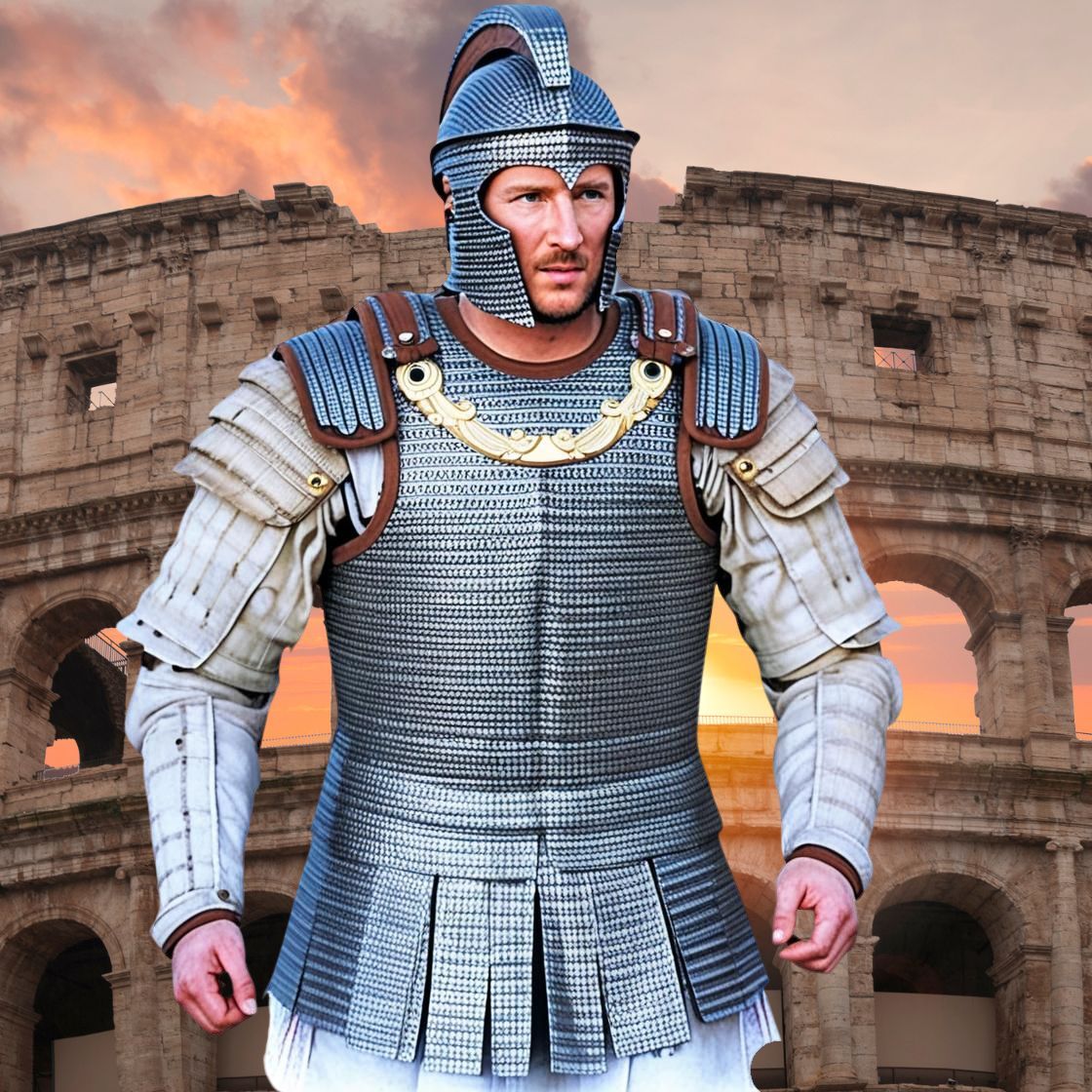
Use and Historical Significance
The **Lorica Hamata** was used throughout the development of the Roman Empire, becoming the standard for auxiliary troops and central to the equipment of the legionaries. It represented a significant advancement in military technology, offering an optimal combination of protection and mobility. Its design allowed soldiers to fight effectively and for extended periods due to its relatively low weight and adaptability. Additionally, the Lorica Hamata was durable and easy to maintain, allowing for the repair or replacement of damaged parts with ease, making it viable for prolonged use.
Impact on Military Technology
The influence of the **Lorica Hamata** transcended the Roman military sphere, affecting other civilizations throughout the vast Empire. From Brittania to North Africa, and from Hispania to the eastern frontiers, the design of the Lorica Hamata expanded its reach, reflecting its importance in military history. These contributions not only improved the effectiveness of Roman soldiers but also laid the foundations for future armors in subsequent centuries.
The **Lorica Hamata** is not only fundamental to understanding the military tactics of ancient Rome, but it also illustrates the skill of innovation and adaptation in ancient warfare technology. Its legacy endures as a testament to Roman engineering and military strategy.
The Gjermundbu helmet is one of the most emblematic pieces of Viking archaeology and offers a fascinating glimpse into military tactics and culture at the end of the 9th century. This impressive defensive helmet, classified within the type known as "spectacle helmets," has captured the attention of historians and archaeologists due to its unique design and historical importance. Below, we will explore its features, history, and significance in detail.
Features of the Gjermundbu Helmet
The Gjermundbu helmet is a remarkable example of Viking metallurgical skill. Here are its most notable features:
- Origin and Era: Although its roots are found in the Vendel Era, the helmet was mainly used during the Viking Age, around the year 875. This period is known for the frequent conflicts and territorial expansion of the Vikings.
- Design: The helmet is made of iron and consists of three main plates that form a semi-spherical structure. These plates are joined by riveted metal, ensuring its solidity. The design includes a distinctive spectacle-shaped face guard that is both functional and indicative of the style.
- Face Guard: The front of the helmet features a metal visor that protected the face of the wearer, an essential feature of "spectacle helmets." This element would have provided crucial defense in close combat.
- Connection with Neck Guard: At the base of the helmet, there are holes that were likely used to connect the helmet with a neck guard. This accessory, similar to a chainmail, provided additional protection to the user.
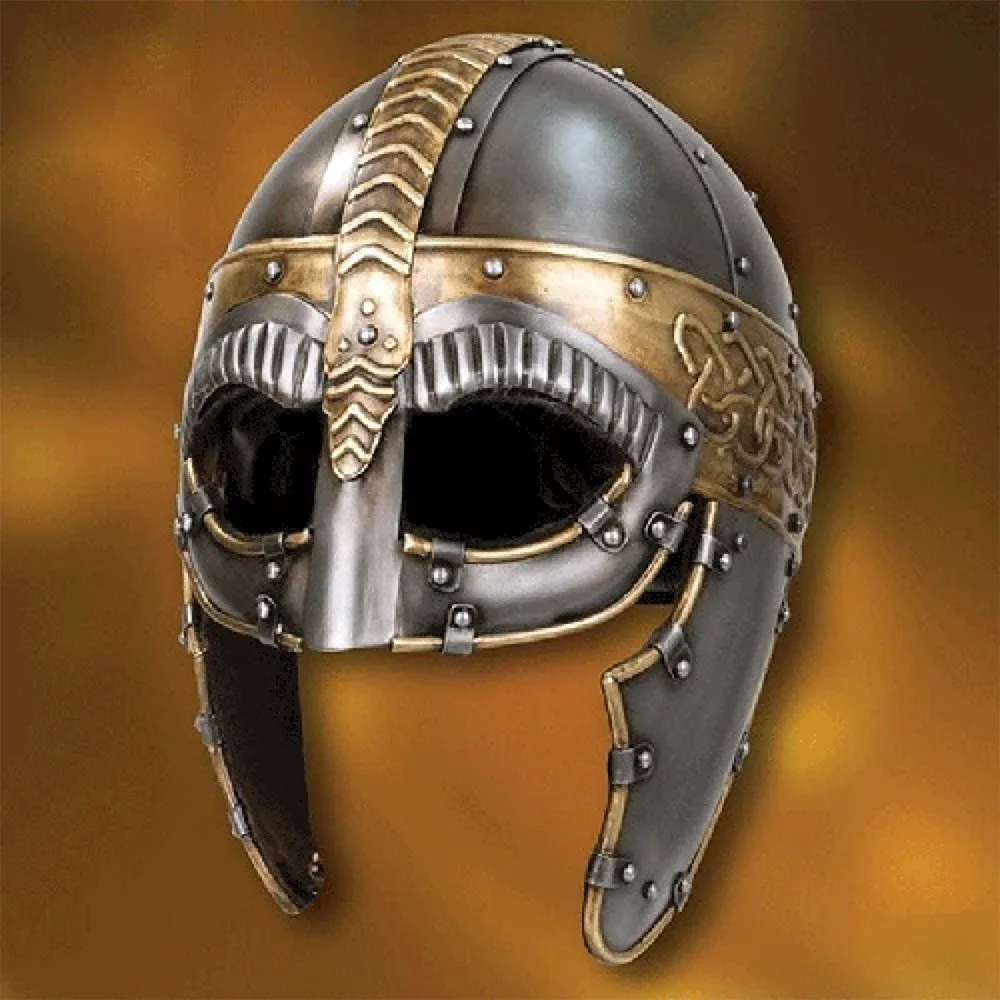
Discovery and Historical Context
- Discovery: The helmet was unearthed on March 30, 1943, by Lars Gjermundbu, in Ringerike, Norway. It was found in fragments within a burial mound, suggesting Viking funerary customs.
- Funerary Context: The objects recovered from the grave indicate that they belonged to a person of high status, such as a noble or monarch from the kingdom of Ringerike. Among these items were swords, spears, axes, and equestrian equipment, typical accessories of a high-ranking warrior.
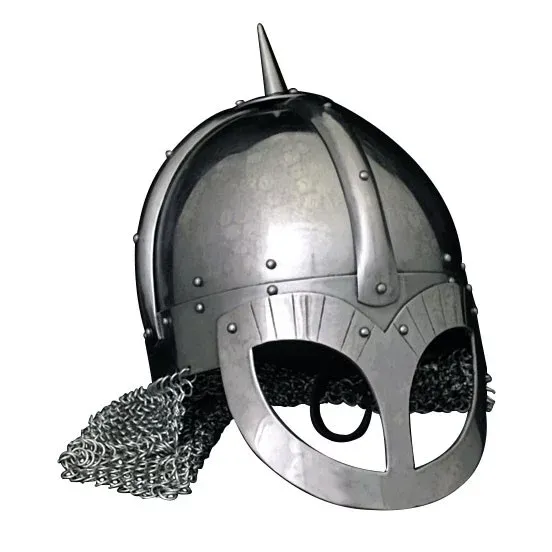
Historical Significance
- Importance: Notably, the Gjermundbu helmet represents the only completely intact example of a Viking helmet discovered to date. This fact emphasizes its uniqueness and advanced craftsmanship.
- Reserved for Royalty: It is believed that only individuals close to royalty or leaders of the hird, the king's personal retinue, wore helmets of this type. This suggests that such equipment was a symbol of prestige and power in Viking society.
Conservation and Exhibition
- Currently: The Gjermundbu helmet is on display at the Historical Cultural Museum of Oslo. It is considered one of the museum's gems, attracting visitors interested in the Viking Age and its legacy.
The Gjermundbu helmet is not only a highly valuable archaeological finding but also a window into the world of Viking warfare and its social hierarchies. It reflects not only mastery in metalworking but also the deep symbolism of these weapons and armors for the Vikings of the medieval era.
The Kettle hat, also known as the war helmet or chapel de fer, is an iconic piece of medieval armor, notable for its design that resembles a cooking pot or cauldron, hence its name in English. This helmet was made of iron or steel and was characterized by its wide brim, providing effective protection. Throughout the centuries, the Kettle hat has been used by various types of fighters, becoming an essential element of war equipment in the Middle Ages.
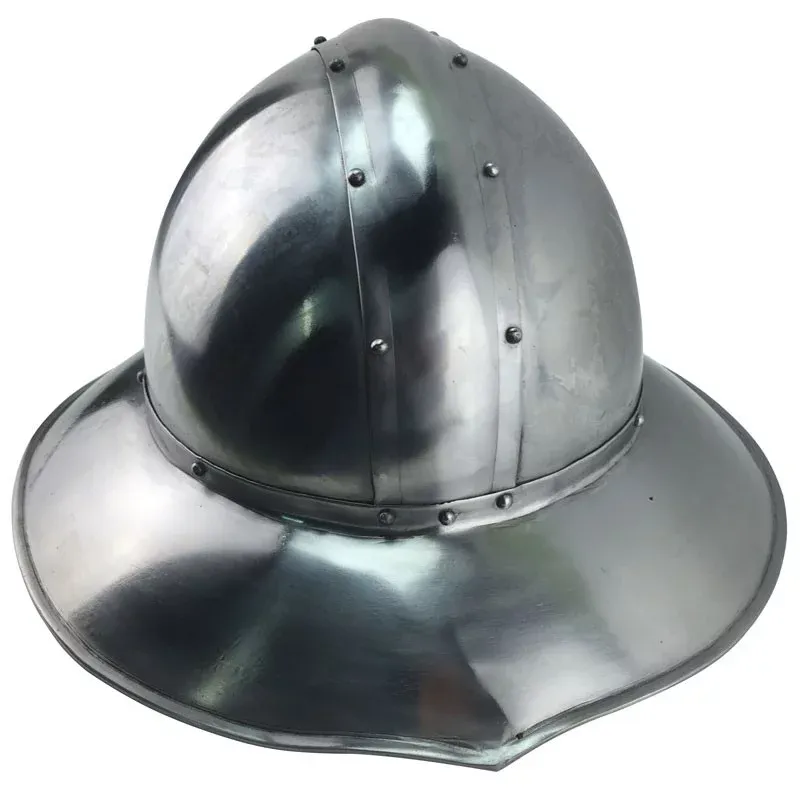
Main characteristics of the Kettle hat
The design of the Kettle hat is simple yet extraordinarily functional, contributing to its popularity during the Middle Ages. Some of its outstanding features include:
- Cone-shaped or rounded dome: protects the top of the head.
- Wide brim: provides additional protection for the face, neck, and shoulders.
- Robust construction: made from a single piece of metal or by joining plates.
- Facial opening: ensures good visibility and breathing.
- Option for additional protection: allows for the addition of a mesh coif to protect the neck and sides of the head.
History and use
The Kettle hat emerged in Europe around the 12th century and was extensively used until the 16th century. It found common ground among various groups of fighters, such as:
- Infantry: its low cost and ease of production made it ideal.
- Archers and crossbowmen: did not obstruct vision during combat.
- Light cavalry: balanced protection and mobility.
Its effectiveness lay in the balance between protection and comfort, allowing soldiers to see and breathe without restrictions, while also protecting them from arrows and downward strikes.
Advantages of the Kettle hat
This medieval helmet offered various advantages over other designs of the time:
- Effective protection: especially against blows and projectiles from above.
- Visibility and ventilation: the wearer could see and breathe freely.
- Lightweight and comfortable: suitable for prolonged use.
- Simple production: easy to manufacture in large quantities.
- Versatility: suitable for different types of fighters and combat situations.
Variations and evolution
Over time, the design of the Kettle hat evolved, adapting to new needs:
- Movable visors: added for greater facial protection.
- Extensions: for better neck protection and sides of the head.
- Reinforcements and ribs: increased the helmet's durability.
- Chainmail and gorgets: incorporated for added protection.
By the 16th century, more elaborate variations such as the Spanish morion and the Italian cabasset emerged, but the basic concept of the protective wide brim prevailed.
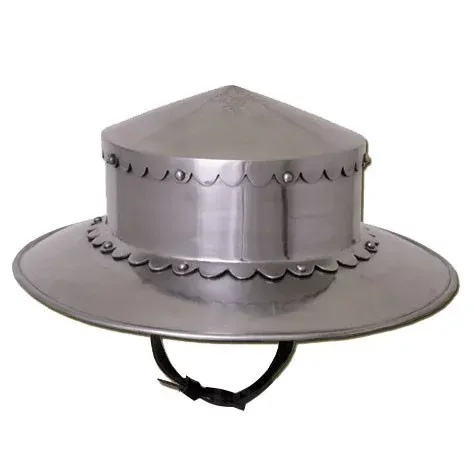
Legacy and influence
The design of the Kettle hat left a lasting mark on the history of military helmets. In World War I, it was reflected in the creation of the British Brodie helmet and the French Adrian helmet, both drawing on the idea of the protective wide brim. Today, the Kettle hat remains an iconic symbol in historical representations, film, and video games that take us back to the Middle Ages, faithfully representing the common soldier of the time.
The Kettle hat not only played a crucial role in the personal defense of medieval soldiers, but its design also influenced future generations of military equipment. It is an example of how a simple and effective solution can withstand centuries of technological evolution and remain relevant in many aspects.
The *bevor* stands out as a key piece in the history of medieval armor. Its main function, to protect the vulnerable areas of the face and neck, was crucial at a time when close combat posed a considerable risk of receiving fatal wounds. This component, often made from a single piece of steel or iron, was placed between the helmet and the breastplate, providing essential reinforcement against enemy attacks.
Origin and Historical Evolution
Since its emergence in the 14th century, the bevor became an inseparable component of the *sallet* helmet, a type of open helmet that required additional protection for the chin and throat. As combat techniques and tactics evolved, so did the bevor, especially during the 15th century, with the development of articulated versions known as *falling buffe* in the 16th century. These innovations allowed warriors to lift or lower the protection as needed, which was essential for facilitating communication and breathing in non-combat situations.
Features and Construction
The previously mentioned component was typically made from steel blocks 1 to 2 mm thick, handcrafted to fit the wearer. Here are some of its most notable features:
- Specific Protection: It provided comprehensive coverage for the chin, throat, and sometimes the neck and part of the left shoulder.
- Compatibility: It was designed to be used with *sallet*, *close helm*, and *burgonet* helmets.
- Composition: Made with fixed or articulated pieces, held in place with straps and buckles.
- Aesthetics: It showcased a refined Gothic design, often with polished or dark finishes that reflect the aesthetics of the period.
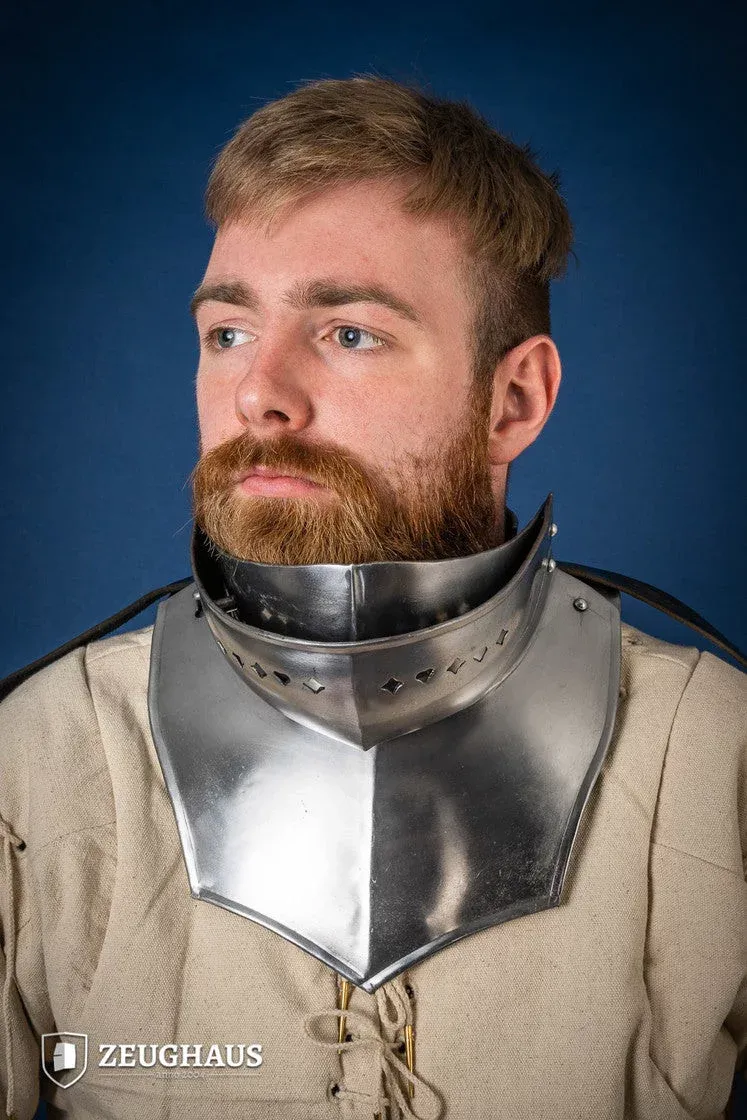
Importance and Function in Combat
Its place in combat was undeniable, reducing the risk of injuries to the lower face and neck, which are highly vulnerable areas. However, some knights chose not to wear the bevor constantly due to the restrictions it imposed on breathing and hearing. Stories of confrontations such as the Wars of the Roses emphasize that not wearing a bevor significantly increased the risk of severe injuries.
Differences between Bevor and Gorget
Although they are easy to confuse, the *bevor* and the *gorget* differ substantially. While the gorget is designed to protect the lower neck, the bevor extends to the chin, providing greater facial coverage. There are models that combine both concepts, such as chin gorgets, which offer even broader protection.
Legacy and Current Use
Today, the bevor remains an important element for history enthusiasts, appearing in historical recreations and *reenactment* events. Modern armorers faithfully reproduce this piece, offering multiple finishes and thicknesses, adapting to the aesthetic and functional needs of contemporary users.
In its evolution from a simple fixed plate to an elaborate articulated piece, the *bevor* reflects the adaptability of medieval armor to the challenges of combat. Even today, it stands out as an object of interest, preserving the rich tradition of European armor.
The term Outrance, also known as Profight, represents one of the most intense and technical variants of medieval combat, commonly referred to as buhurt. Inspired by mixed martial arts and designed to emulate medieval confrontations, this type of duel allows fighters to don historical armor and use blunted steel weapons. The main objective is to rigorously and safely simulate the challenges faced by warriors in the medieval era.
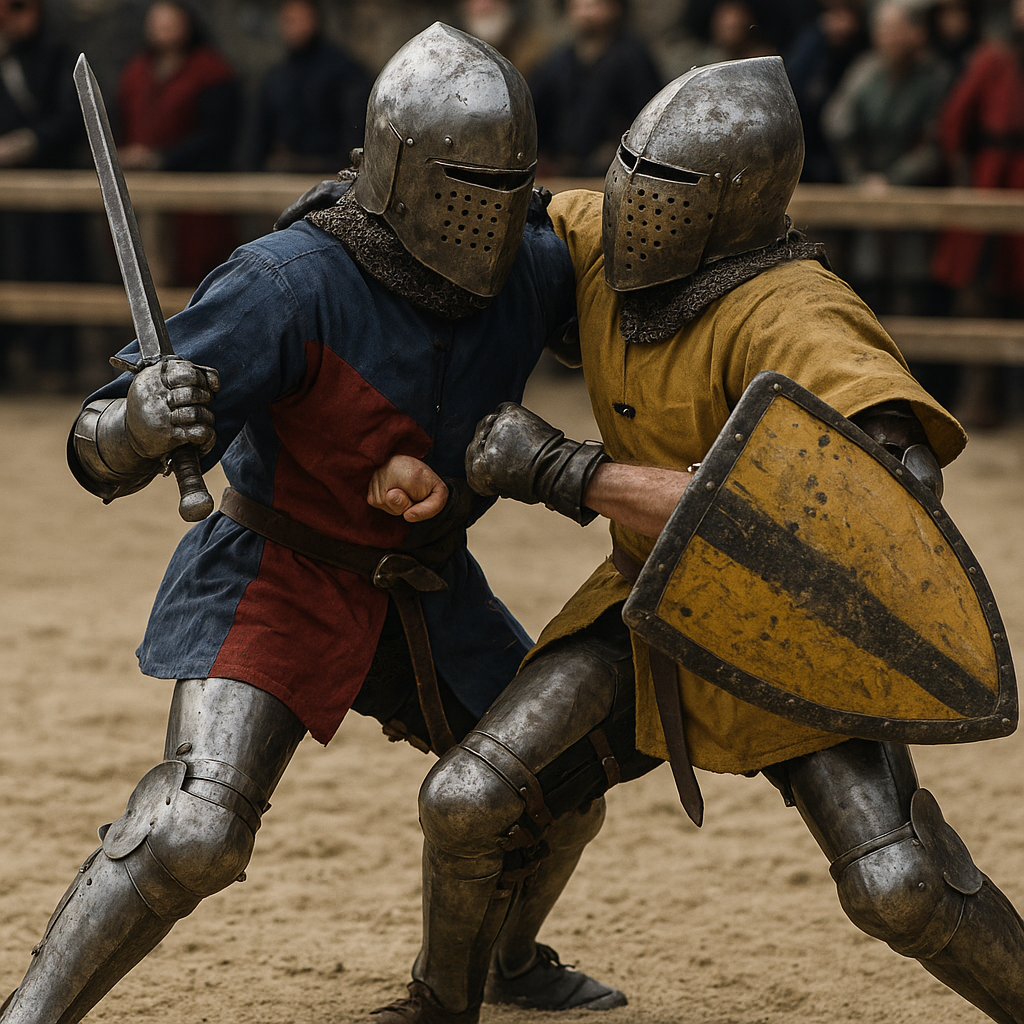
Features of Outrance (Profight)
- Individual Combat: Unlike traditional group melees of buhurt, Outrance focuses on personal duels between two fighters. This one-on-one match tests both the physical supremacy and the technical skills of the participants.
- Total Contact: The rules of Outrance allow for a greater variety of techniques compared to other modalities, such as strikes with weapons, punches, kicks, grappling, and throws. All of this is done within a safety framework established by official regulations.
- Specific Regulations: It is supervised by internationally renowned organizations like HMBIA and Buhurt International. These entities define the valid target areas for striking and establish prohibited actions to ensure fair and safe combat.
- Duration and Rounds: Outrance fights are usually divided into timed rounds, for example, three rounds of one or two minutes each. The winner is determined by points, technical knockout, or submission.
The Scoring System in Outrance
Instead of focusing on knocking down the rival team as in group combats, Outrance emphasizes the technical precision of strikes, impact, and space control. Judges evaluate clean hits and the actions taken to subdue the opponent. The result can be determined by points accumulated during the confrontation or by a decisive victory such as a technical knockout or submission.
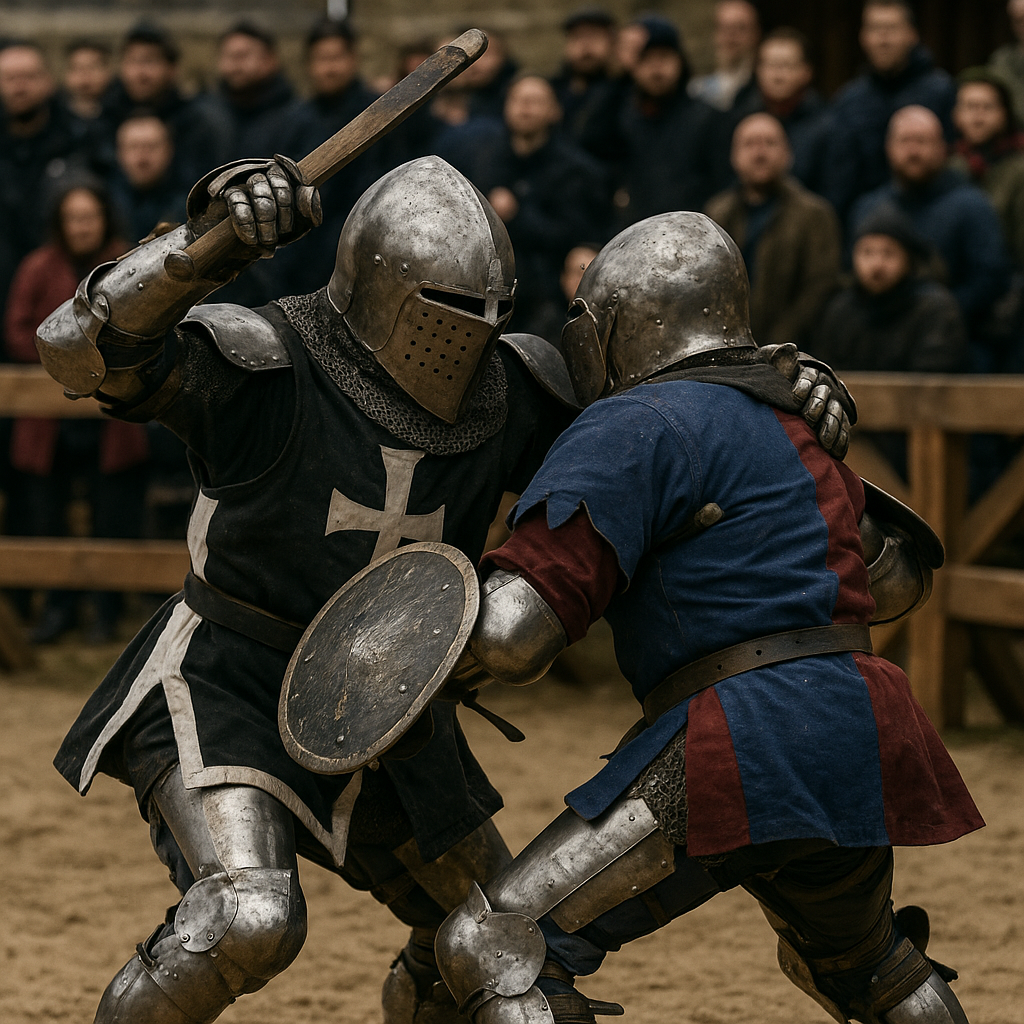
Differences between Outrance and Traditional Buhurt
| Aspect | Outrance (Profight) | Traditional Buhurt |
|---|---|---|
| Modalities | Individual duels | Group combat (teams) |
| Contact rules | More techniques allowed (strikes, kicks, grappling, and throws) | Additional restrictions on striking and grappling techniques |
| Objective | Defeat the opponent through points, submission, or technical KO | Physically eliminate opponents on the rival team |
| Scoring | Based on technical assessment and rounds | Elimination of opponents |
| Sporting similarity | Mixed martial arts/boxing | Rugby/ice hockey/group wrestling |
Safety and Regulations
Although Outrance may seem extremely physical, it is strictly regulated to minimize the risk of serious injuries. Only blunted steel weapons are used, the armor follows sports and historical standards, and there is a clear list of prohibited techniques, such as strikes to the neck, back of the head, groin, in addition to certain dangerous holds.
In the world of buhurt, Outrance (Profight) represents the most technical and demanding side, ideal for those looking to elevate the medieval combat experience to a regulated intensity level. It combines tradition and modernity, making each duel a spectacle where skill, strategy, and safety are paramount.
```The aventail, also known as camail, is a key piece in the history of medieval armor. Its unique design not only provided effective protection but also reflected the ingenuity of medieval technology. This flexible curtain, made of metal mesh, was attached to helmets, known as helmets, to safeguard vital areas such as the neck, throat, shoulders, and sometimes the upper chest.
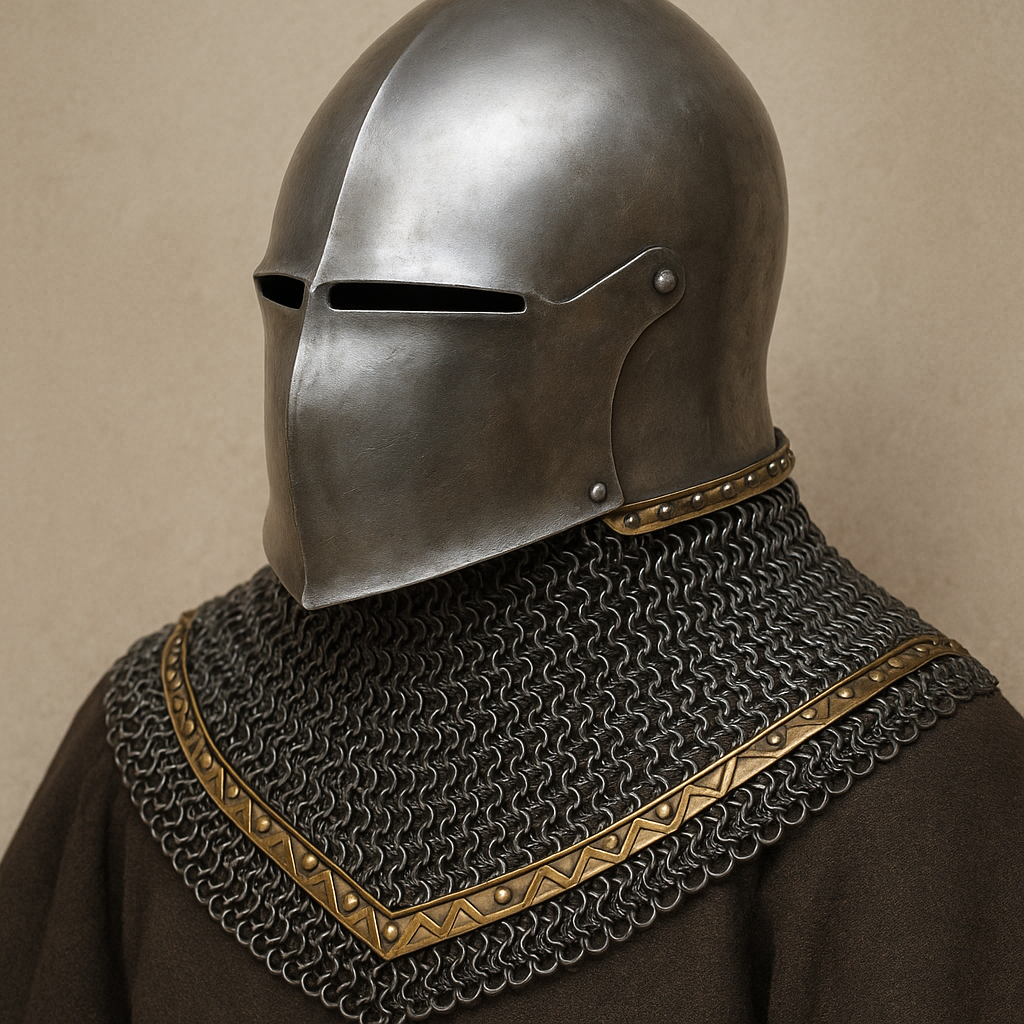
Origin and Evolution of the Aventail
The term "aventail" is derived from the Arabic "tarás," which means "shield." This defensive piece has a rich history that dates back several centuries in Europe.
Early Appearances
Mesh aventails were integrated into helmets in Northern Europe as early as the 6th century, as demonstrated by archaeological findings from the Vendel Era. Notable examples include the Valsgärde 8 helmet from Sweden and the Coppergate helmet from England. These early aventails varied in design: while the Valsgärde 8 helmet featured an aventail covering the lower face, throat, and neck, the Coppergate helmet combined cheek protectors with a neck aventail.
High Middle Ages
During the High Middle Ages, the aventail experienced innovations, especially in its integration with "spectacle" visors or nasal guards, as seen in various medieval helmets from the Rus and Kievan Rus. Some configurations even allowed for a "ventail," a mobile mesh flap for greater flexibility in combat.
Features and Variants
Aventails came in various configurations:
- Integrated with chainmail: Initially, they were part of the chainmail coif attached to the chainmail shirt, but soon they began to be made as separate pieces.
- One-piece: They completely covered the neck area.
- With flap: Some designs included a flap that attached to the coif to cover the chin.
- Scaled aventail: They offered greater protection compared to simple mesh.
Attachment Systems
The method of attachment to the helmet was crucial for its effectiveness. Holes were drilled in the helmet to pass a leather strap, or special rivets called "vervelles" were used.
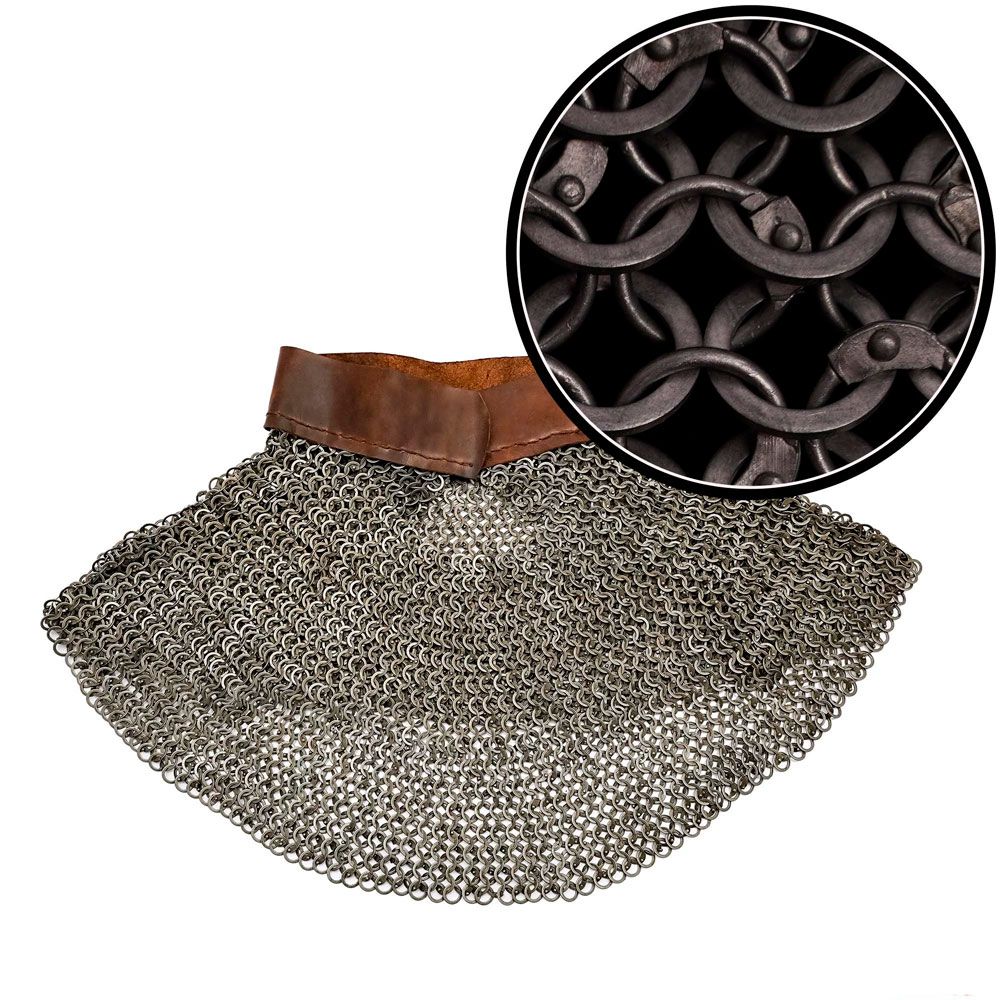
Evolution and Challenges of the Aventail
With the arrival of the bascinet in the 14th and 15th centuries, the aventail became an integral part of helm design. This type of helmet underwent several modifications, including taller skulls and sharply pointed profiles that were later softened and rounded.
Transition to Plate Gorget
Around 1350, French bascinets began to be equipped with a hinged jawpiece called a "bevor," which improved protection by shifting the weight of the mesh from the head to the shoulders.
Advantages and Use in Battle
The flexibility of the aventail allowed combatants to move unrestricted, making it popular among medieval warriors. In turn, it provided adequate ventilation and prevented chafing, especially when worn over padded clothing to cushion blows.
However, shortly after 1450, the aventail was mainly replaced by other forms of lighter and more flexible protection, such as the armet and the sallet, marking the decline of its use in battles.
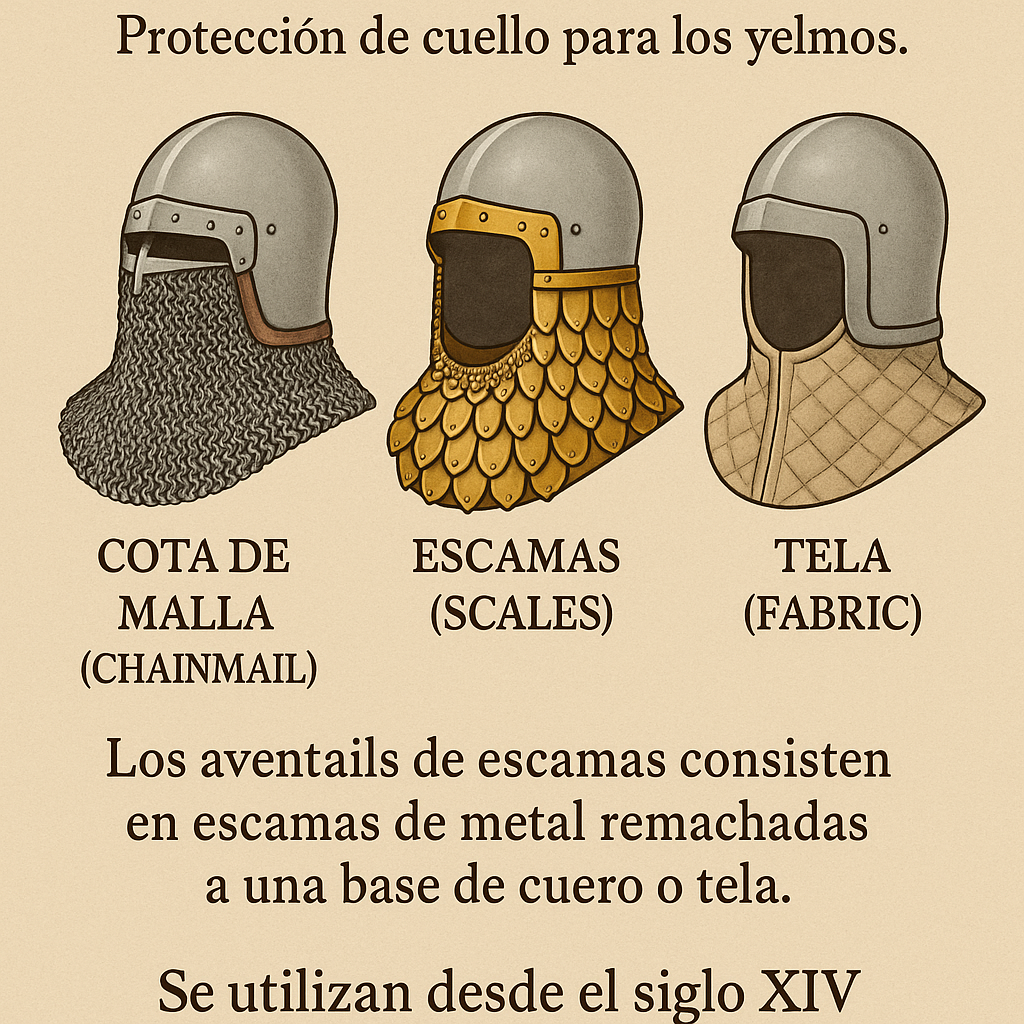
| Type of Aventail | Features |
|---|---|
| Integrated with chainmail | Joint piece with chainmail shirt |
| One-piece | Completely covers the neck |
| With flap | Includes coverage for the chin |
| Scaled aventail | Superior protection with a scaled design |
In the fascinating world of **Buhurt**, a modern discipline of medieval combat known as historical fighting, the role of the **Marshal** is fundamental. This sport, which has gained popularity in various parts of the world, is characterized by intense fights that simulate the jousts of the 14th and 15th centuries with replicas of armor and non-lethal weapons. The marshal stands as the central figure who ensures safety and justice in each competition, guaranteeing compliance with the rules and ensuring the historical authenticity of the equipment.

This emerging sport, originating from Russia and Eastern Europe, has found its way to Latin America, Western Europe, and Asia, bringing with it the rich tradition of medieval battles and tournaments. Within this context, marshals are authority figures who ensure that the game remains safe, organized, and authentic.
Types of Marshals in Buhurt
In Buhurt, the arbitration system consists of different types of marshals, each with unique responsibilities that ensure each combat takes place in an orderly and safe manner:
- Knight Marshal: Considered the highest authority, the Knight Marshal leads the team of marshals and has the final say on penalties. They ensure that the equipment meets historical and safety standards, also supervising the management of other marshals.
- Field Marshal: Located within the combat area known as "the list," these marshals directly manage the confrontations, paying special attention to group battles.
- Line Marshal: They act outside the combat area, keeping records of results, weapon loss, and armor errors, and serve as counters in individual duels.
- Technical Marshal: This marshal oversees and approves equipment changes during encounters, in collaboration with the Knight Marshal.
- Authenticity Committee Representative (AC Rep): This committee ensures that all clothing and equipment meet historical requirements, validating this aspect before each competition.

Main Responsibilities of the Marshal
The responsibilities of the marshal are as varied as they are critical to the success of any Buhurt event. Among their main functions are:
- Implementation and enforcement of all event and combat rules.
- Inspection and verification of the safety of equipment and armor.
- Intervention in case of violations or inappropriate conduct, ensuring a safe and fair competitive environment.
- The ability to make informed decisions in unforeseen situations during fights.
- Supervision of the authenticity and technical adequacy of the equipment.
The marshal's attire, featuring distinctive yellow and black colors inspired by the 14th to 16th centuries, facilitates their identification during combats, ensuring that their presence and authority are always visible and respected.
Importance of the Marshal
The marshal is more than just a referee in Buhurt; their role is to be a guardian of the essence and tradition of the sport, ensuring that competitions are not only safe and fair but also true to their historical roots. Their rigorous training and commitment to these principles are fundamental to the growth and global acceptance of Buhurt as a sport.
Marshals are invisible, but their impact is monumental. Every fight conducted with safety, fairness, and adherence to the historical code is a testament to their hard work and commitment.
The growing popularity of Buhurt internationally, with events such as the International Buhurt World Championship scheduled for 2025, further underscores the importance of this essential figure in the competitive arena. With the global expansion of the sport, especially in regions like Latin America, where Mexico stands out for its associations and organized events, the marshal's role transcends the mere arena of combat, solidifying their status as a central figure in the sporting legacy of Buhurt.
In the fascinating world of **Buhurt**, a modern discipline of medieval combat known as historical fighting, the role of the **Marshal** is fundamental. This sport, which has gained popularity in various parts of the world, is characterized by intense fights that simulate the jousts of the 14th and 15th centuries with replicas of non-lethal armor and weapons. The marshal stands as the central figure ensuring safety and justice in each competition, guaranteeing compliance with the rules and ensuring the historical authenticity of the equipment.

This emerging sport, originating from Russia and Eastern Europe, has found its way to Latin America, Western Europe, and Asia, bringing with it the rich tradition of medieval battles and tournaments. Within this context, marshals are authority figures that ensure the game remains safe, organized, and authentic.
Types of Marshals in Buhurt
In Buhurt, the arbitration system is composed of different types of marshals, each with unique responsibilities that guarantee every fight proceeds in an orderly and safe manner:
- Knight Marshal: Considered the highest authority, the Knight Marshal leads the team of marshals and has the final word on sanctions. They ensure that the equipment meets historical and safety standards, also overseeing the management of other marshals.
- Field Marshal: Located within the combat area known as "the list," these marshals directly manage the confrontations, paying special attention to group battles.
- Line Marshal: They operate outside the combat area, keeping track of results, weapon losses, and armor errors, and act as counters in individual duels.
- Technical Marshal: This marshal supervises and approves equipment changes during the matches, in collaboration with the Knight Marshal.
- Authenticity Committee Representative (AC Rep): This committee ensures that all clothing and equipment meet historical requirements, validating this aspect before each competition.

Main Functions of the Marshal
The responsibilities of the marshal are as varied as they are critical to the success of any Buhurt event. Among their main functions are:
- Implementation and enforcement of all event and combat rules.
- Inspection and verification of equipment and armor safety.
- Intervention in cases of violations or inappropriate behavior, ensuring a safe and fair competitive environment.
- Ability to make informed decisions in unforeseen situations during fights.
- Supervision of the authenticity and technical adequacy of the equipment.
The marshal's attire, with its distinctive yellow and black colors inspired by the 14th to 16th centuries, facilitates their identification during fights, ensuring that their presence and authority are always visible and respected.
Importance of the Marshal
The marshal is more than just a referee in Buhurt; their role is to be a guardian of the essence and tradition of the sport, ensuring that competitions are not only safe and fair but also true to their historical roots. Their rigorous training and commitment to these principles are fundamental to the growth and global acceptance of Buhurt as a sport.
Marshals are invisible, but their impact is monumental. Every fight conducted with safety, fairness, and adherence to the historical code is a testament to their hard work and commitment.
The growing international popularity of Buhurt, with events like the International Buhurt World Championship scheduled for 2025, further underscores the importance of this essential figure in the competitive arena. With the global expansion of the sport, especially in regions like Latin America, where Mexico stands out for its associations and organized events, the role of the marshal transcends the simple arena of combat, establishing itself as a central figure in the sporting legacy of Buhurt.
```Buhurt is a sport that revives the essence of ancient medieval tournaments, where the safety of the combatant is paramount. In this context, essential components arise to ensure protection, such as ocular bars. These provide crucial defense at one of the most vulnerable points of the armor set: the eye slot of medieval helmets.
What are Ocular Bars in Buhurt?
Ocular bars are metal plates specifically designed to be installed inside the helmets used in Buhurt. Their main function is to protect the eye slot, preventing weapons or fragments from reaching the combatant's eyes. Although they are not historically documented for use in authentic helmets, these bars are permitted in modern Buhurt competitions as long as they meet certain requirements.
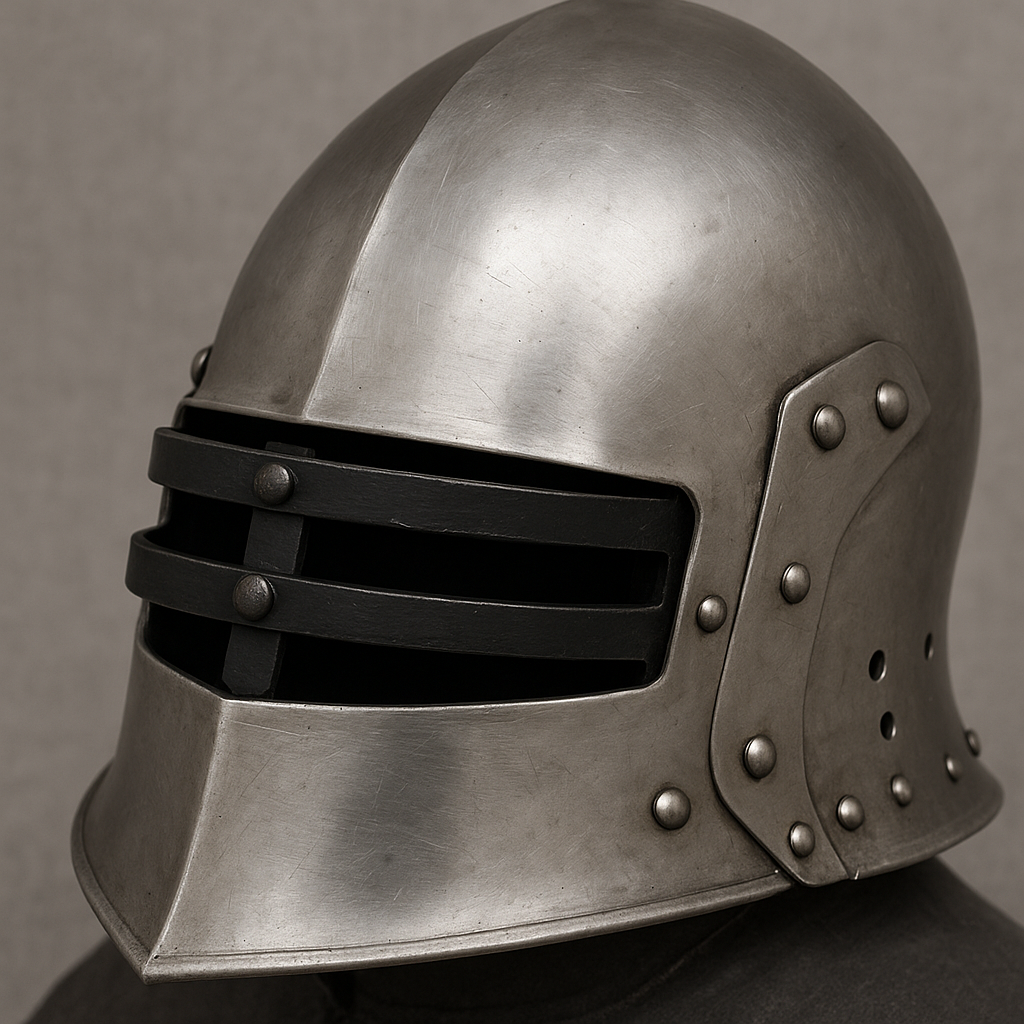
Key Features of Ocular Bars
- Effective protection: They completely cover the eye slot, ensuring that no weapon can penetrate to the eyes.
- Safety dimensions: It is recommended that the opening between the bars does not exceed 25 mm.
- Variable installation: In helmets with side-hinged visors, internal bars can be added tailored to the design of the helmet.
- Visual consistency: Any historically undocumented design must be painted black, preserving the historical aesthetics of combat.
Functioning within Medieval Combat
Modern Buhurt seeks to balance historical authenticity with current safety needs. Although replicas of medieval armor and weapons are used, elements such as ocular bars have been enhanced to ensure that the combats are as safe as possible. Strict standards like the prohibition of blows to vulnerable areas reinforce safety, and ocular bars play a crucial role in this system.
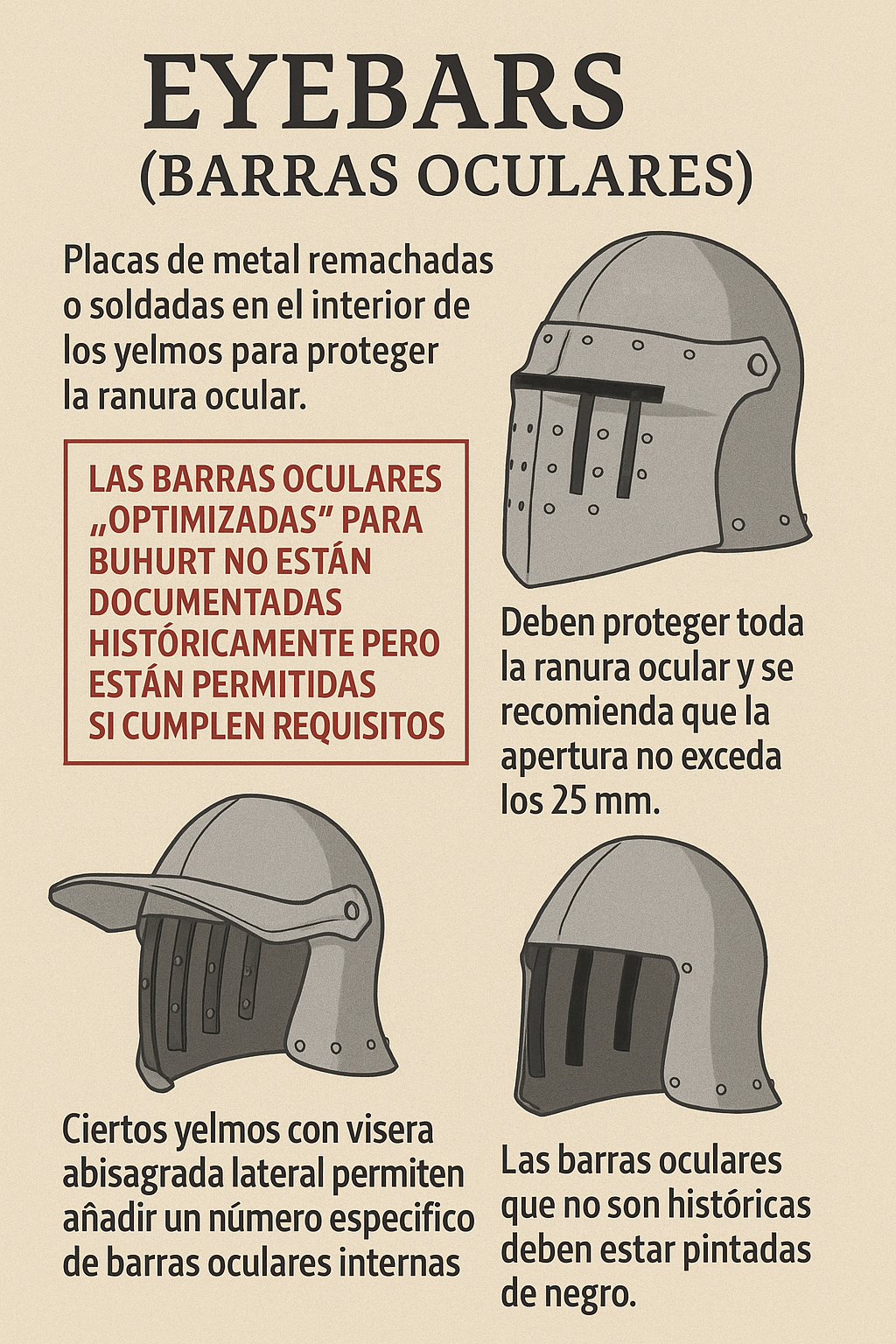
Considerations for Practitioners and Manufacturers
For combatants, ocular bars are not merely an optional component; they are an essential part of protective gear. It is important that the helmets are designed with the installation of these bars in mind, respecting both safety and historical appearance.
- Recognized standards: Ensure that the helmet and ocular bars meet the standards set by the leading Buhurt organizations.
- Conscious manufacturing: Those who manufacture armor should integrate ocular bars as part of the design, balancing aesthetics and protection.
Ultimately, the evolution of safety elements like ocular bars demonstrates the adaptation of modern Buhurt, which honors the legacy of medieval combat while protecting its practitioners under contemporary safety standards.
The gauntlets, also known as mittens, are an essential piece of medieval armor that served to protect the hands, fingers, wrists, and part of the forearm of knights during combat. Designed to provide effective defense, these artifacts were vital on the battlefield as they offered protection without sacrificing the necessary maneuverability to handle weapons.
Origin and History of Gauntlets
The history of gauntlets dates back to the time of the Persians, who were pioneers in using hand protections in warfare, initially made from tough leather. However, over the centuries, they underwent significant evolution to adapt to the new demands of medieval warfare.
- 11th and 12th centuries: During this period, gauntlets were made of chainmail, evolving from the sleeves of the hauberk. In France, they featured an opening at the cuff to free the hand when necessary.
- 14th century: The separation of the fingers was introduced, which improved the dexterity of the knights.
- 15th century: The shape evolved into gauntlets, with steel pieces molded to follow the natural structure of the hand.
- 16th century: The invention of the pistolet led to a redesign, allowing full separation of the fingers to handle firearms.
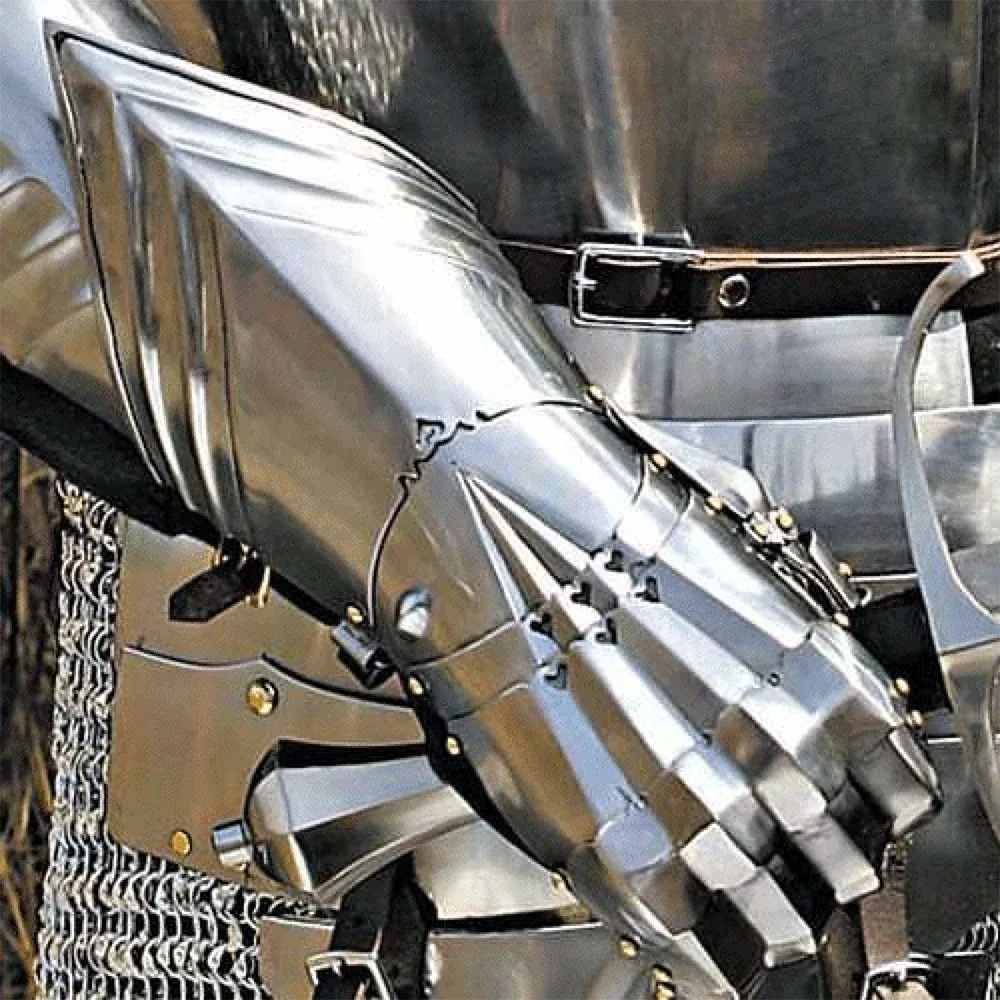
Types and Characteristics of Gauntlets
Throughout medieval history, different types of gauntlets were developed, each designed for a specific function in combat:
- Jousting gauntlet: Worn on the left hand during jousts, it lacked finger articulation, as its primary function was to withstand impacts.
- Slashed gauntlet: Characterized by separated fingers and multiple articulated pieces, serving as a differentiation from single-piece models.
During the tournaments of the 15th and 16th centuries, it was common for knights to wear a mixed configuration, using different models for each hand depending on their main function in combat.
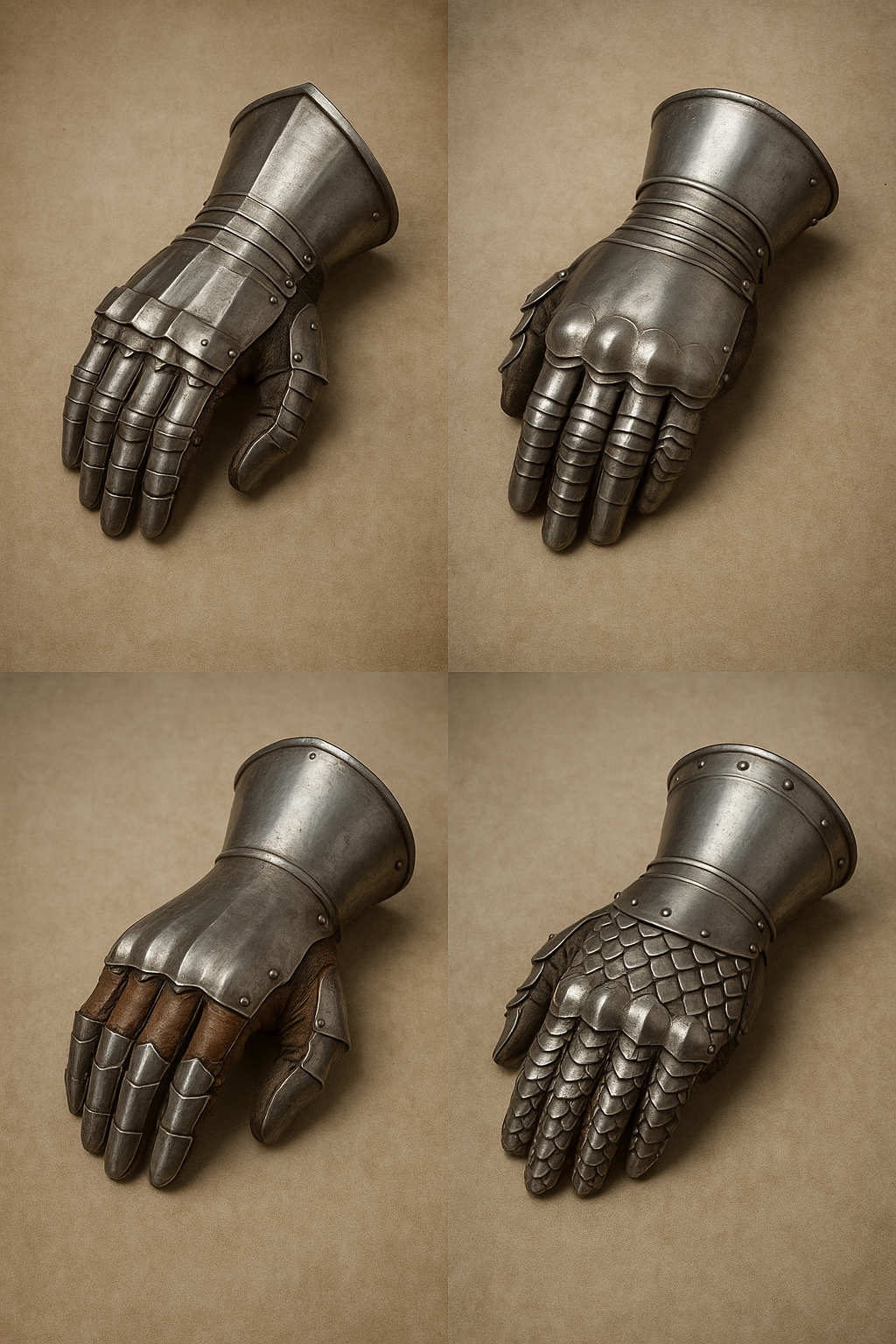
Materials and Manufacturing
Gauntlets were primarily made of sheets of steel that followed the shape of the hand and fingers, a process that required remarkable precision. During the Gothic period, some models consisted of numerous articulated pieces to ensure both protection and agility.
The typical fastening system included leather straps and brass buckles, providing a secure fit that allowed the knight to use their hands effectively during combat.
Importance on the Battlefield
More than simple accessories, gauntlets were essential elements for the safety of knights, offering crucial defense against enemy weapons. Their design continuously evolved to find the perfect balance between protection and mobility. They withstood blows and cuts while allowing the user to handle weapons with skill, reflecting the innovation in combat techniques and metallurgy of that time.
Gauntlets Today
Today, gauntlets have transcended their original function. Transformed into collector's items and decorative elements, they are also used in historical reenactments. Among current models are:
- Mittens and articulated gauntlets that offer different levels of mobility and protection.
- Gothic and Milanese designs, recognized for their beauty and ornamental details.
- Fantasy models for use in medieval fairs and live role-playing events.
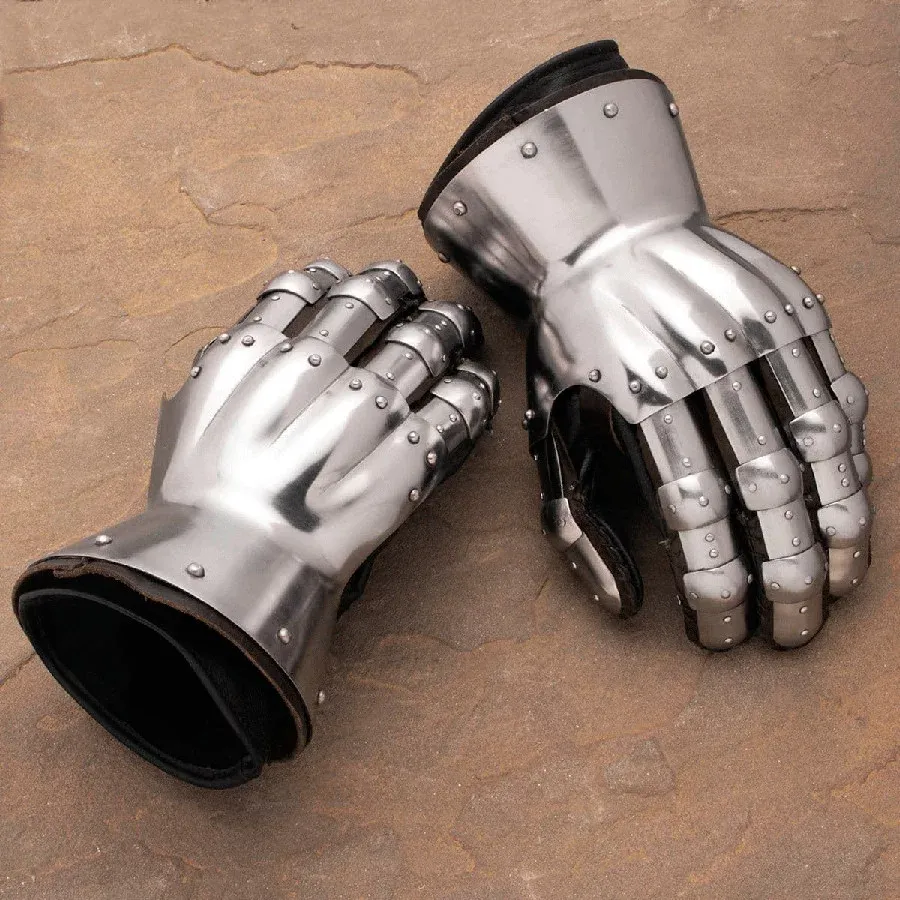
For collectors and participants in reenactments, maintaining gauntlets is essential. Leather models require regular cleaning, and steel ones must be kept free of rust through cleaning and oiling.
The evolution of gauntlets from simple leather gloves to sophisticated pieces of art and protection illustrates humanity's ability to innovate in adapting to new challenges, reflecting centuries of development in the art of war and offering a fascinating glimpse into the past for enthusiasts and historians alike.
The gambeson and the arming jacket (aka aketon) share origins and materials but have different functions and designs within medieval defensive equipment. This article clearly and practically explains what each garment is, their uses, key differences, and how they influenced the evolution of European armor.
What is a gambeson?
The gambeson is a padded garment made from layers of fabric (linen, wool, or cotton) filled to absorb impacts. It could be used as standalone protection or as a base layer under other armors, such as chainmail or plate armor. Its popularity spans from the Early Middle Ages to the Modern Age, especially among soldiers who could not afford metal armor.
- Main function: Cushioning cutting and blunt blows; reducing the effect of focused impacts.
- Variety of thicknesses: From thin gambesons for use under mail to extremely thick models capable of being the sole protection.
- Comfort and weight distribution: Prevents chafing and distributes loads when worn under metal pieces.
- Accessibility: Relatively simple materials and construction, allowing for widespread adoption.
- Versatility: In some cases reinforced with leather pieces or mail inserts to improve local protection.

What is the arming jacket (aketon)?
The arming jacket is a shorter, fitted version of the gambeson, specifically designed as a base for plate armor. Its name (aketon) comes from European contexts related to cotton and quilted tailoring. Rather than an alternative to the gambeson, it is a technical evolution aimed at securing and providing comfort with heavy armor.
- Fitted design: Shorter, tailored cut that prevents folds and overlaps with plates.
- Reinforcements and attachment points: Seams and reinforcements for sewing straps and mail pieces at strategic points (armpits, neck, groin).
- Optimized thickness: Generally less bulky than a heavy gambeson to facilitate mobility and allow plate adjustment.
- Technical function: Acts as an interface between leather/metal and the body, absorbing chafing and distributing forces.
- Typical users: Mainly knights and soldiers armored with full plate armor.

Key differences — point by point
- Purpose: The gambeson offers versatile padded protection; the arming jacket serves as a structural base to attach plates.
- Length and cut: Gambeson is usually longer (sometimes thigh-length); jacket is short and fitted to the torso.
- Thickness: Gambeson varies greatly; the jacket tends to be thinner but reinforced at specific points.
- Audience: Gambeson: the entire troop. Jacket: full armor users.
- Added elements: The jacket includes attachment points for straps and mail; the gambeson may not include them except in specialized versions.
How did this affect combat?
The existence of both solutions shows the growing specialization of equipment: the gambeson democratized protection on the battlefield, while the jacket allowed plate armor to be more effective and wearable. Where the gambeson prioritized impact absorption, the jacket prioritized mechanical integration between body and metal.
Historical context and evolution
As piercing weapons (powerful bows, crossbows, polearms) and combat techniques evolved, protection also specialized. The gambeson emerged alongside chainmail as a complement or substitute and endured due to its simplicity. The arming jacket gained prominence from the 14th century onward, when white armor and articulated plates required a stable and sturdy base for assembly.
Choice according to modern use (historical reenactment, LARP, study)
- Reenactment of common troops or light combat: Longer, thicker padded gambeson.
- Reenactment of knights with full plate: Fitted arming jacket with attachment points and less bulk.
- Research and testing: Both should conform to historical patterns and use consistent materials to obtain comparable data.
| Characteristic | Gambeson | Arming Jacket (Aketon) |
|---|---|---|
| Main function | Independent padded protection or base for chainmail. | Structural base to attach and support plate armor. |
| Length and cut | Longer, often thigh-length; loose cut. | Short and fitted to the torso; designed not to interfere with plates. |
| Thickness and padding | Variable: from thin to extremely thick depending on use. | Less bulky; reinforced at attachment points. |
| Attachments and reinforcements | Not always present; some versions include reinforcements. | Designed with seams and reinforcements for straps and mail sewing. |
| Typical users | Infantry, guards, people with limited resources. | Knights and soldiers with full plate armor. |
| Typical materials | Linen, wool, cotton, leather; fillings of various fibers. | Mainly thick cotton/linen with internal padding and reinforcements. |
The gambeson and the arming jacket (aka aketon) share origins and materials but have different functions and designs within medieval defensive equipment. This article clearly and practically explains what each garment is, their uses, key differences, and how they influenced the evolution of European armor.
What is a gambeson?
The gambeson is a padded garment made from layers of fabric (linen, wool, or cotton) filled to absorb impacts. It could be used as standalone protection or as a base layer under other armors, such as chainmail or plate armor. Its popularity spans from the Early Middle Ages to the Modern Age, especially among soldiers who could not afford metal armor.
- Main function: Cushioning cutting and blunt blows; reducing the effect of focused impacts.
- Variety of thicknesses: From thin gambesons for use under mail to extremely thick models capable of being the sole protection.
- Comfort and weight distribution: Prevents chafing and distributes loads when worn under metal pieces.
- Accessibility: Relatively simple materials and construction, which allowed for widespread adoption.
- Versatility: In some cases reinforced with leather pieces or mail inserts to improve local protection.

What is the arming jacket (aketon)?
The arming jacket is a shorter, tighter version of the gambeson, specifically designed as a base for plate armor. Its name (aketon) comes from European contexts linked to cotton and padded tailoring. Rather than an alternative to the gambeson, it is a technical evolution aimed at securing and providing comfort with heavy armor.
- Fitted design: Shorter, tailored cut that prevents folds and overlaps with plates.
- Reinforcements and anchor points: Seams and reinforcements for sewing straps and chainmail pieces at strategic points (armpits, neck, groin).
- Optimized thickness: Generally less bulky than a heavy gambeson to facilitate mobility and allow plate adjustment.
- Technical function: Acts as an interface between leather/metal and the body, absorbing chafing and distributing forces.
- Typical users: Mainly knights and armored soldiers with full plate armor.

Key differences — point by point
- Purpose: The gambeson offers versatile padded protection; the arming jacket serves as a structural base to attach plates.
- Length and cut: Gambeson is usually longer (sometimes thigh-length); the jacket is short and fitted to the torso.
- Thickness: Gambeson varies greatly; the jacket tends to be thinner but reinforced in specific points.
- Audience: Gambeson: the entire troop. Jacket: full armor users.
- Added elements: The jacket incorporates anchor points for straps and mail; the gambeson may not include them except in specialized versions.
How did this affect combat?
The existence of both solutions shows the growing specialization of equipment: the gambeson democratized protection on the battlefield, while the jacket allowed plate armor to be more effective and wearable. Where the gambeson prioritized impact absorption, the jacket prioritized mechanical integration between body and metal.
Historical context and evolution
As piercing weapons (powerful bows, crossbows, polearms) and combat techniques evolved, protection also specialized. The gambeson emerged alongside chainmail as a complement or substitute and endured due to its simplicity. The arming jacket gained prominence from the 14th century onward, when white armor and articulated plates required a stable and sturdy base for mounting.
Choice according to modern use (historical reenactment, LARP, study)
- Reenactment of common troops or light combat: Longer, thicker padded gambeson.
- Reenactment of knights with full plate: Fitted arming jacket with anchor points and less bulk.
- Research and testing: Both should conform to historical patterns and use coherent materials to obtain comparable data.
| Characteristic | Gambeson | Arming Jacket (Aketon) |
|---|---|---|
| Main function | Independent padded protection or base for chainmail. | Structural base to attach and support plate armor. |
| Length and cut | Longer, often thigh-length; loose cut. | Short and fitted to the torso; designed not to interfere with plates. |
| Thickness and padding | Variable: from thin to extremely thick depending on use. | Less bulky; reinforced at attachment points. |
| Anchors and reinforcements | Not always present; some versions include reinforcements. | Designed with seams and reinforcements for straps and mail sewing. |
| Typical users | Infantry, guards, people with limited resources. | Knights and soldiers with full plate armor. |
| Typical materials | Linen, wool, cotton, leather; fillings of various fibers. | Mainly thick cotton/linen with internal padding and reinforcements. |
The arming jacket is a typical garment of medieval military clothing that functioned as a padded base to mount and secure the pieces of a plate armor. Also known by its European name aketon, this piece emerged as a shorter and more functional version of the gambeson, designed to offer protection, cushioning, and a stable anchoring point for straps, buckles, and sections of chainmail.
.jpg)
Origin and Historical Context
During the 14th and 15th centuries, the evolution of warfare and metallurgy led to the consolidation of plate armor —often called white armor—. For the metal pieces to function properly on the combatant’s body, a padded base was necessary that:
- Distributed impacts.
- Prevented metal chafing.
- Served to fix straps and chainmail pieces.
This function was performed by the arming jacket. Its name aketon comes from terms related to cotton or quilted fabrics, although in historical practice various materials were used depending on availability and the user’s economic capacity.
Main Characteristics
- Short cut: designed to cover the torso without extending as much as the gambeson, facilitating articulation and the attachment of skirts and plates.
- Internal padding: layers of sewn fabric that create filled chambers —historically with linen, wool, or rags; in modern reproductions with cotton and synthetic fillings— that cushion impacts and friction.
- Anchoring points: straps, eyelets, and sewn reinforcements to fix plate pieces and, in many cases, sections of chainmail (for example, guards under the armpits or neck).
- Compatibility: designed to integrate into multilayer sets: padded jacket + (partial) chainmail + metal plates.

Materials and Manufacture
Historically, jackets were made with sturdy fabrics such as linen, wool, or cotton and filled with layers of fabric or loose fibers sewn into compartments. The padding could be:
- Linear: horizontal or vertical stitches creating padded stripes.
- Quilted: a grid of squares that stabilizes the filling.
- Layered: multiple layers for greater impact absorption.
Additionally, craftsmen reinforced specific areas (shoulders, chest, waist) with stiffer inner pieces or extra stitching to support the weight of the plates.
Practical Functions in Combat and Ceremonies
- Protection against minor impacts: reduces bruising and prevents marks from metal.
- Armor support: keeps plates aligned and prevents shifting during movement.
- Versatility: in worse circumstances, it served as light protection on its own for men with limited resources.
- Adaptability: allowed sewing or attaching chainmail fragments at vulnerable points (armpits, groin, neck) for combined protection.

How It Differed from the Gambeson
Although both are padded garments, the difference lies in purpose and cut: the gambeson is usually longer and sometimes used as sole protection, while the arming jacket is a shortened variant specifically designed to function as a framework and anchoring point for plate armor.
| Element | Arming Jacket | Gambeson |
|---|---|---|
| Length | Short, focused on the torso | Longer, covers torso and part of the pelvis |
| Main use | Base to mount plate armor and sew chainmail sections | Independent protection or base for light armor |
| Typical material | Linen/cotton with padding; reinforcements in key areas | Linen, wool, or cotton with various paddings |
| Chainmail incorporation | Frequent: sewn or attached pieces | Less common |
Relevance and Legacy
The arming jacket represents a clear example of the layered protective logic developed in the Middle Ages: combining padded fabrics with metal and mail to compensate for the limitations of each material. Today it serves as a reference for historical reconstruction and the study of textile and military tailoring techniques, as well as to understand how practical necessity influenced the design of defensive clothing.
















